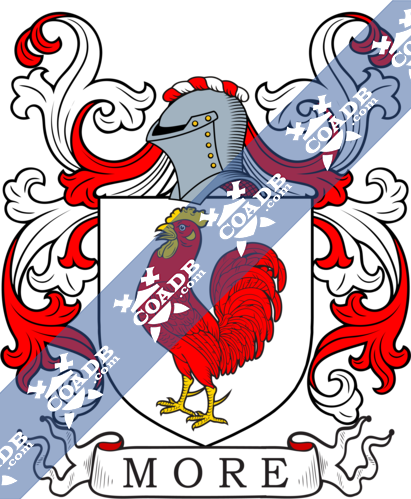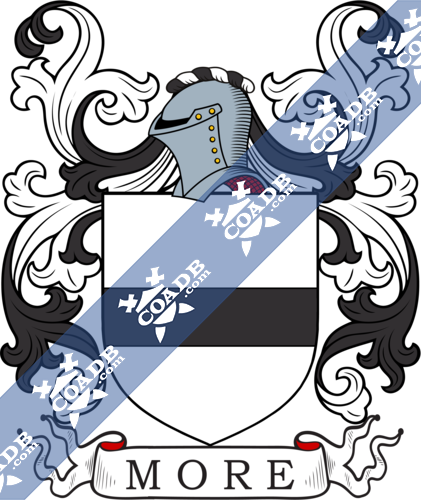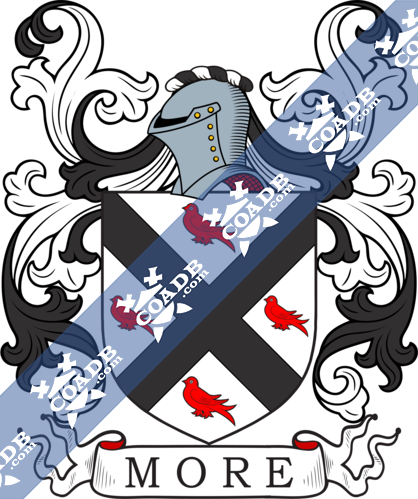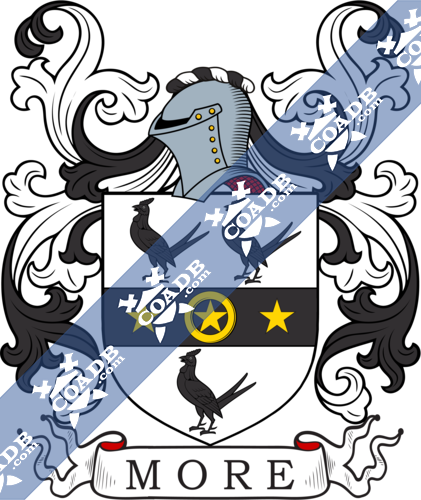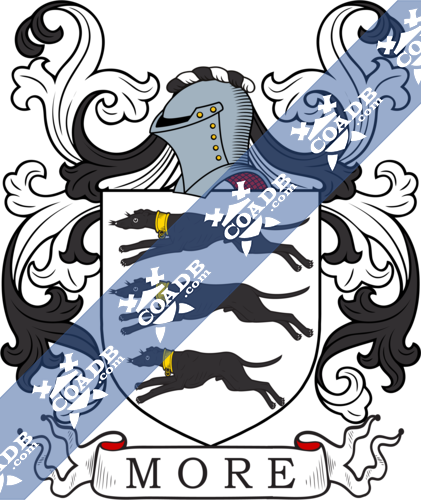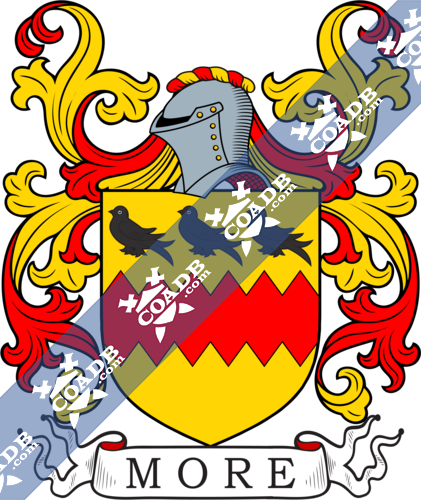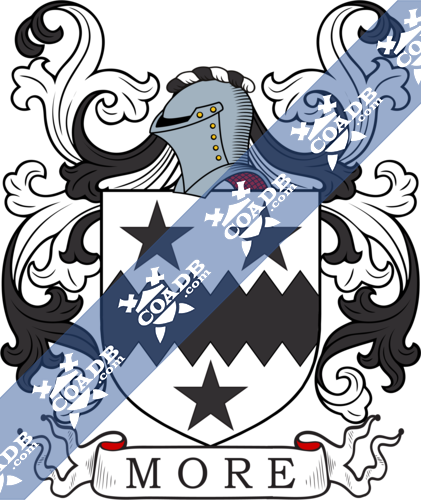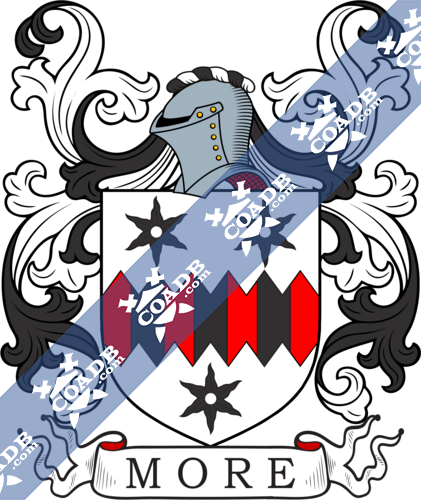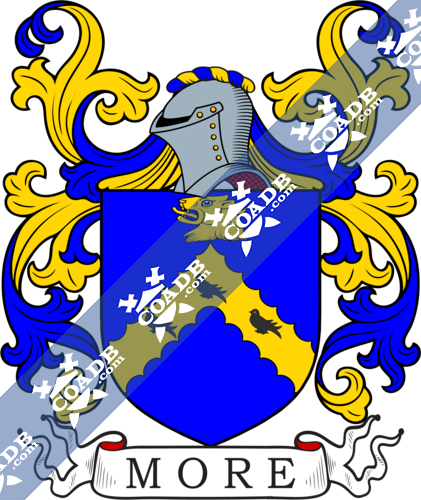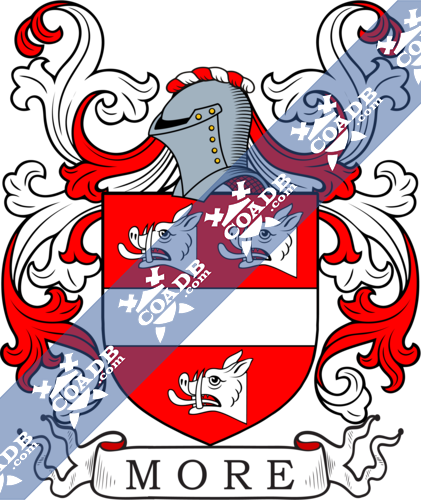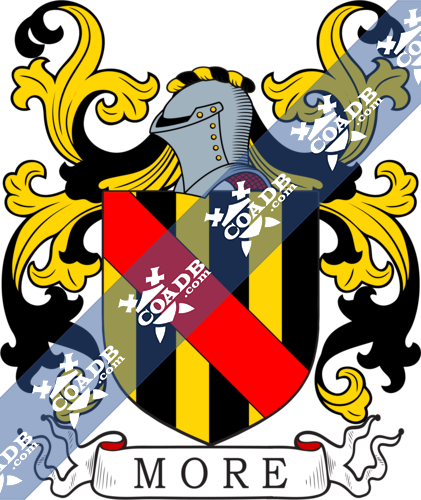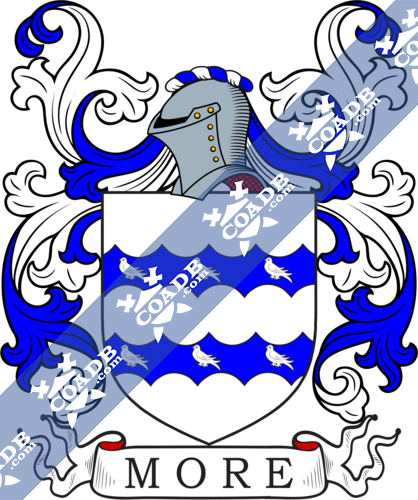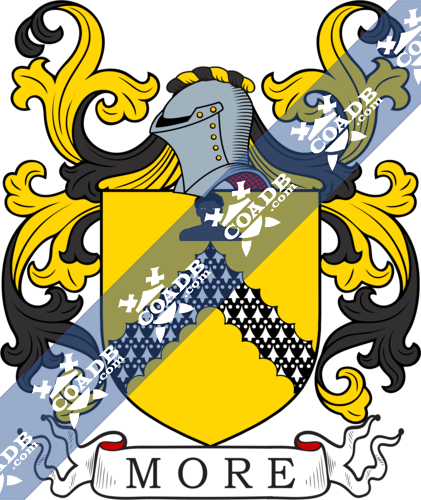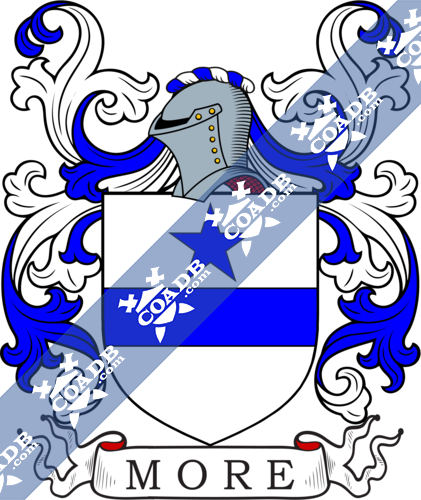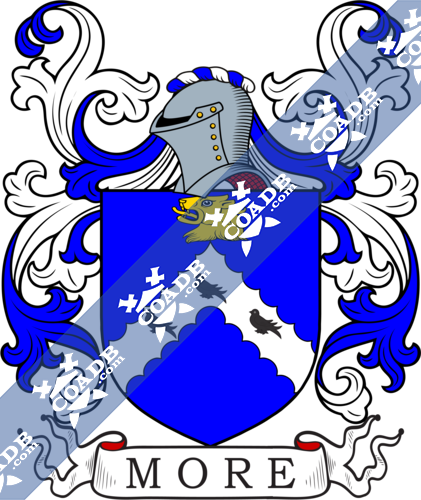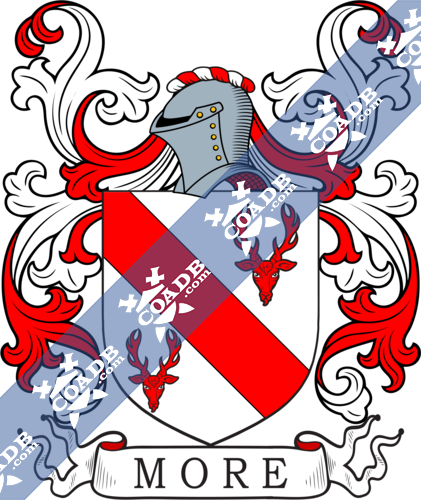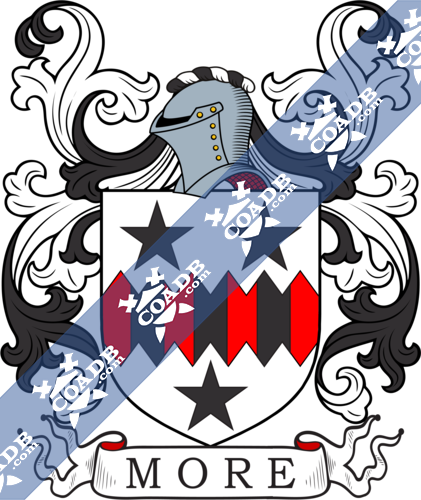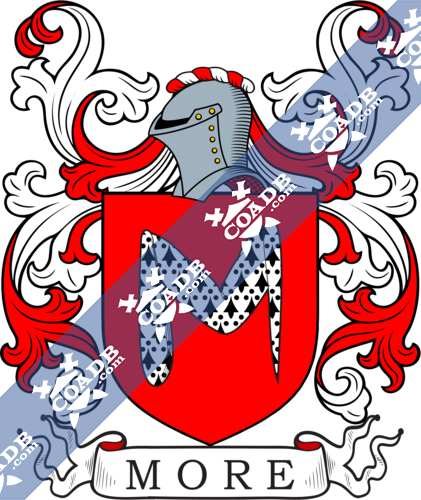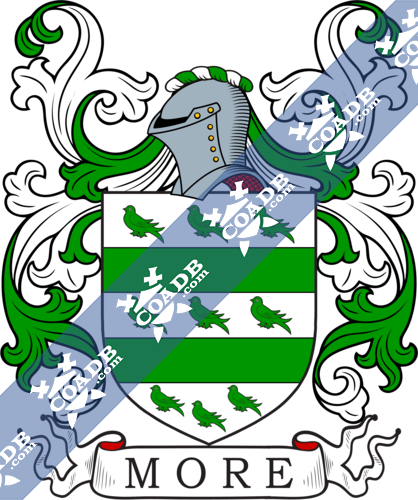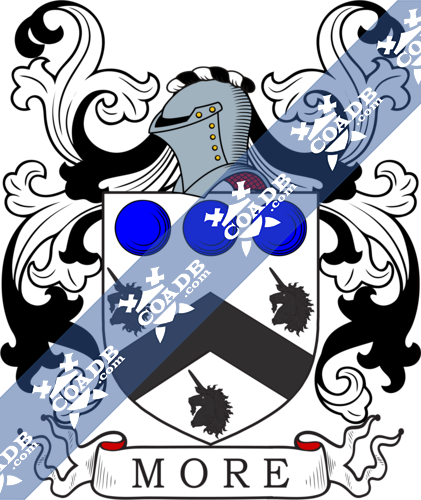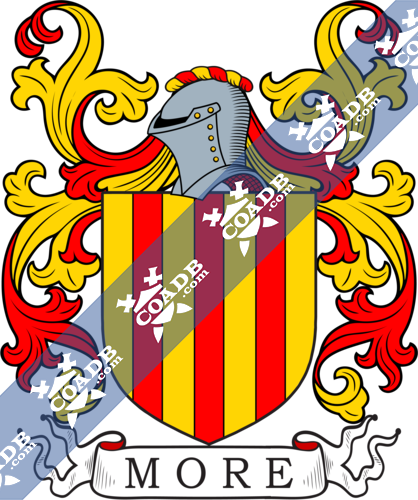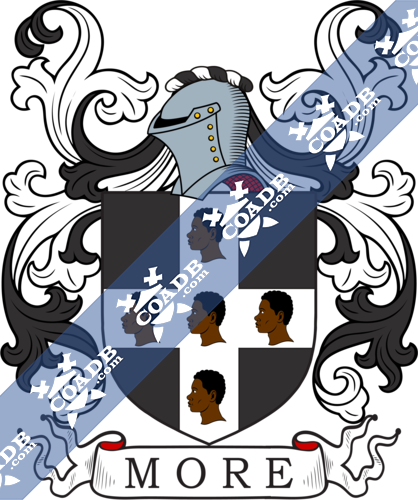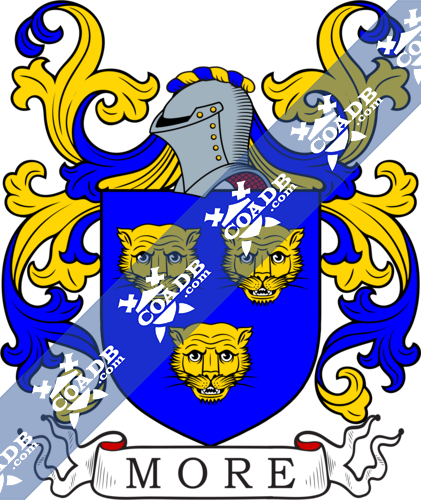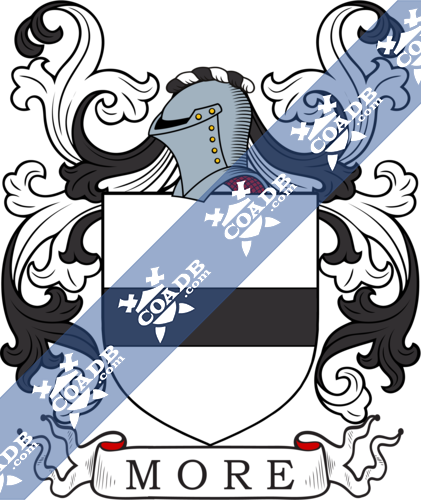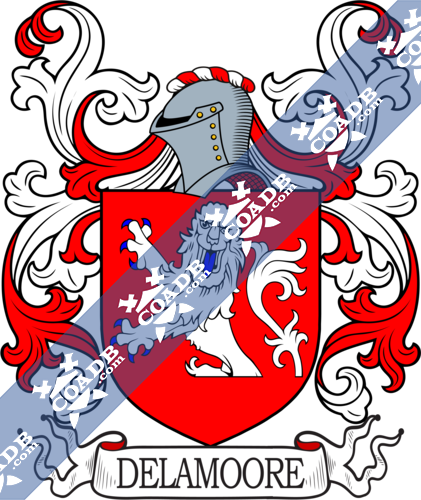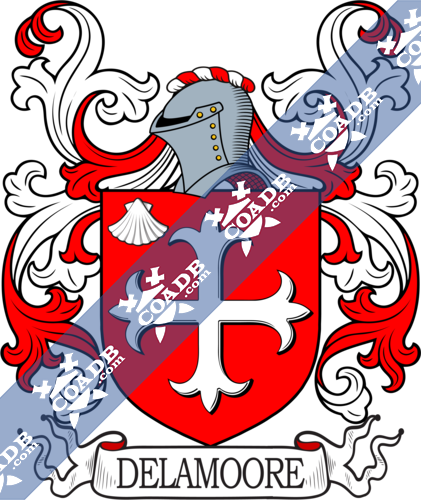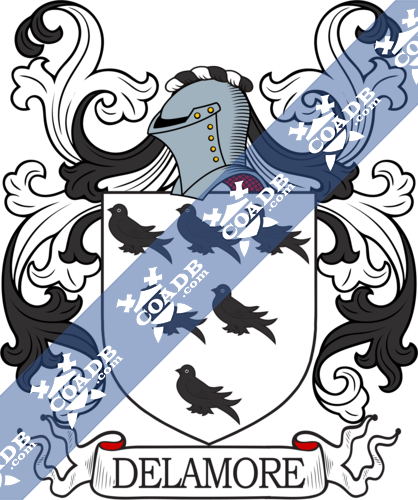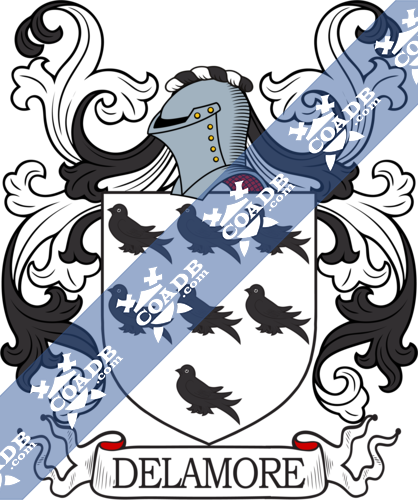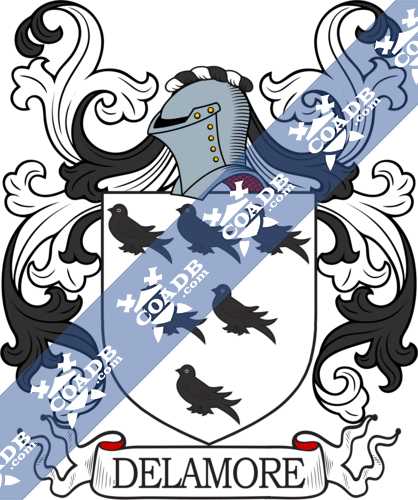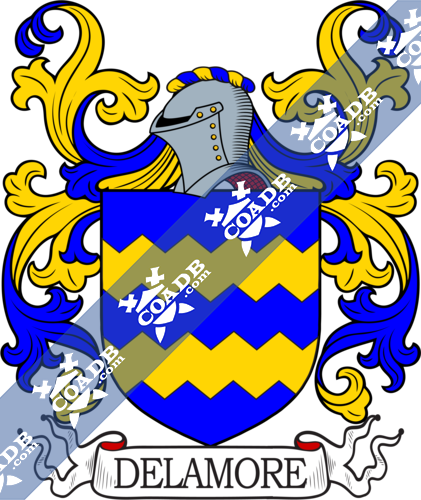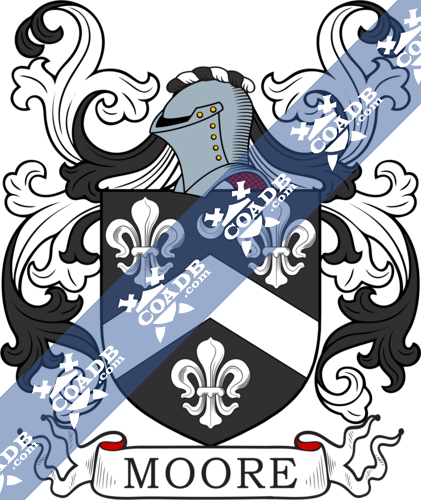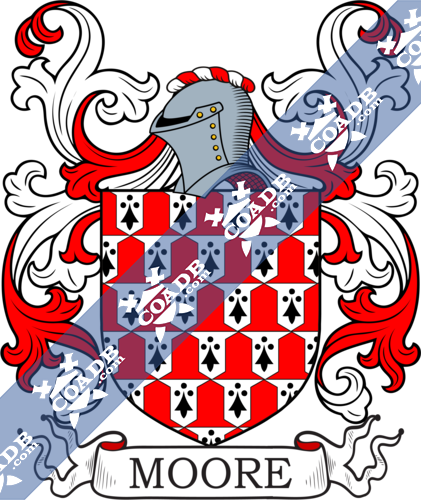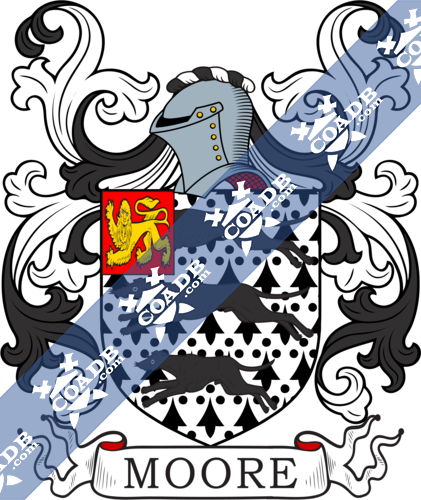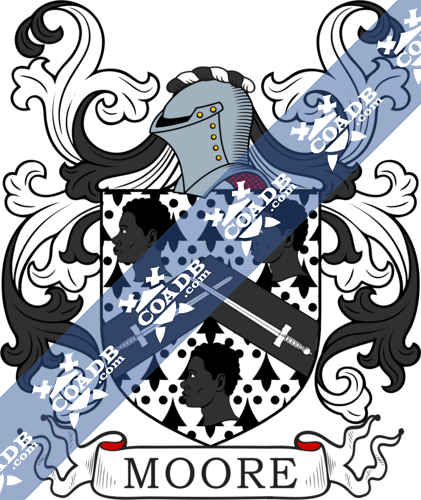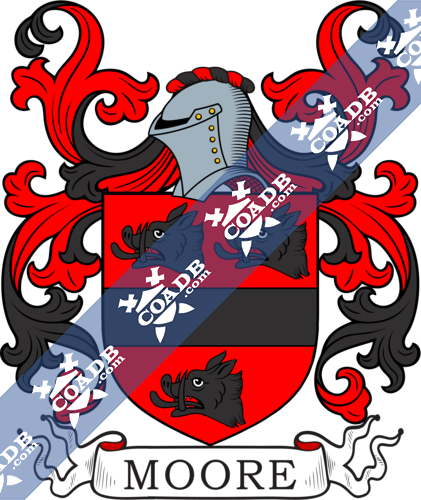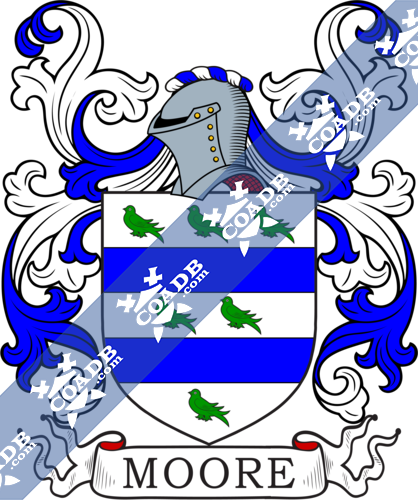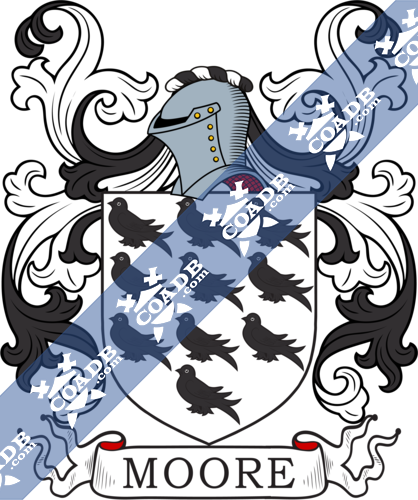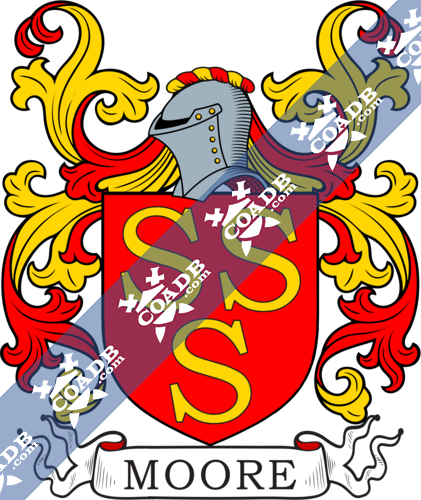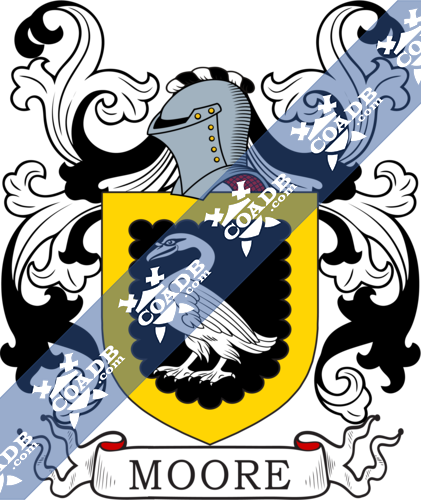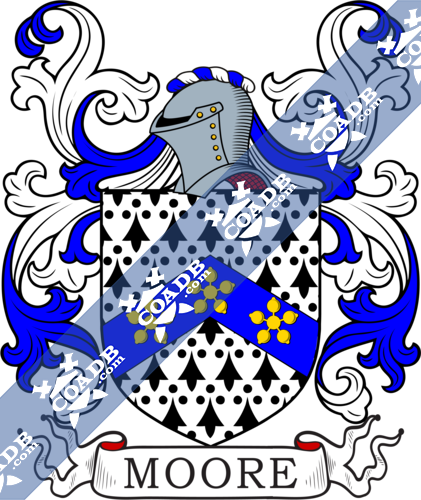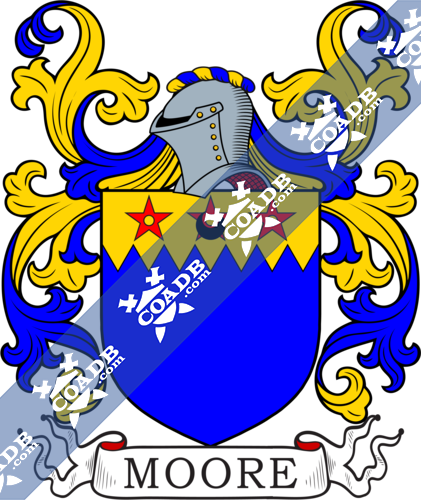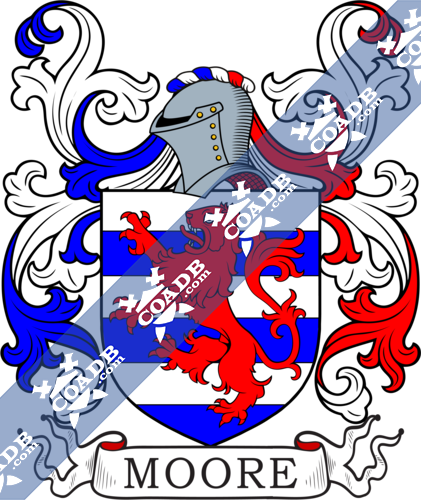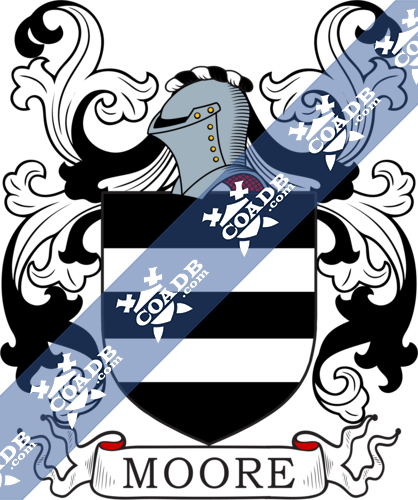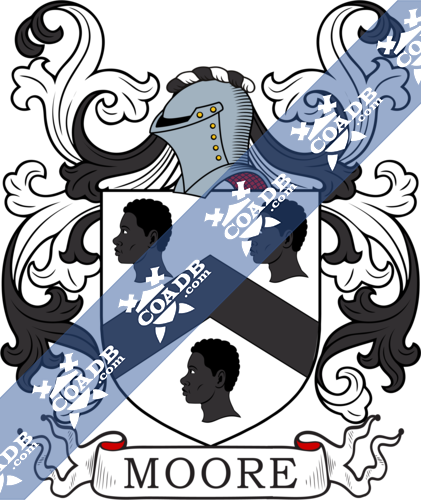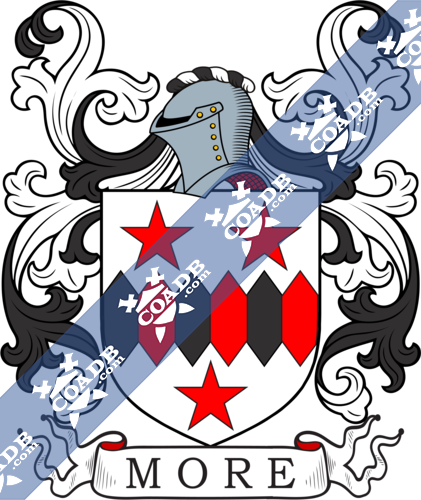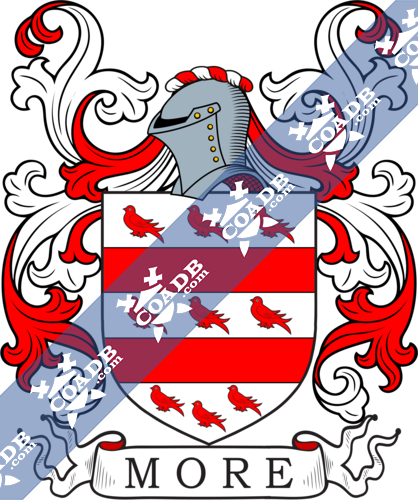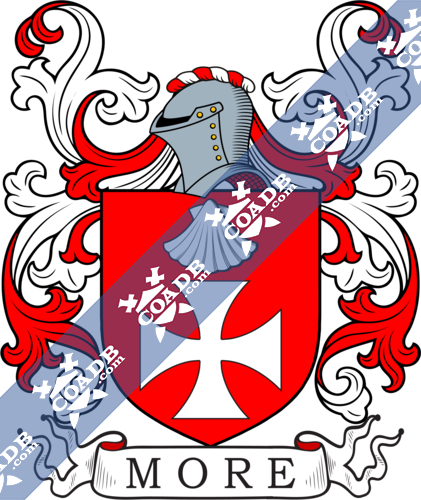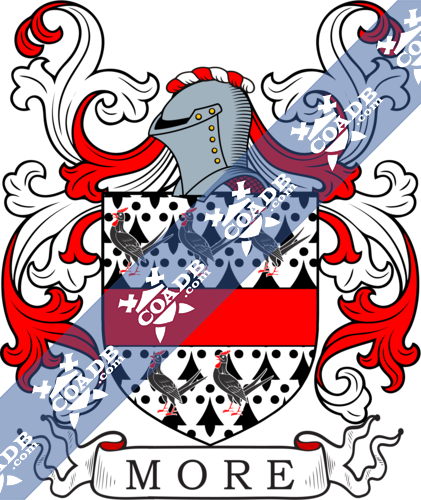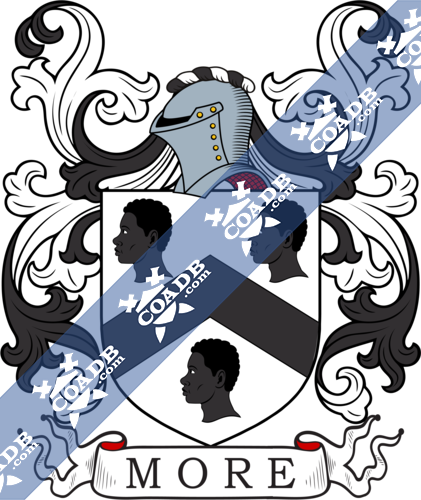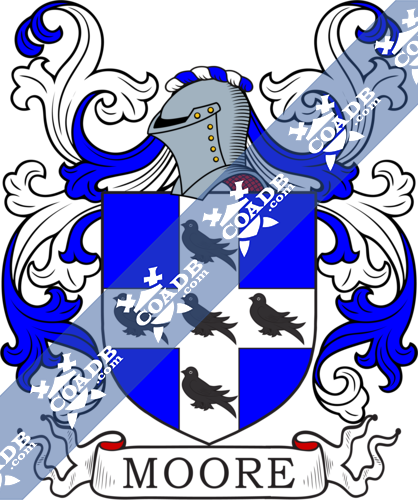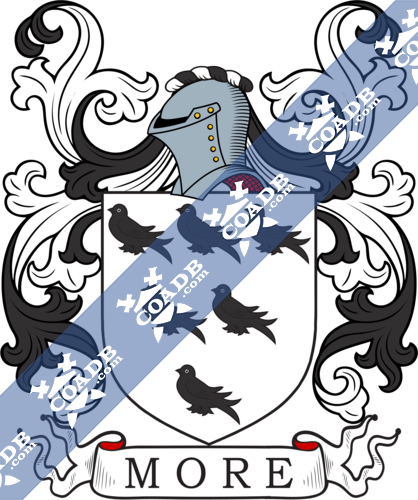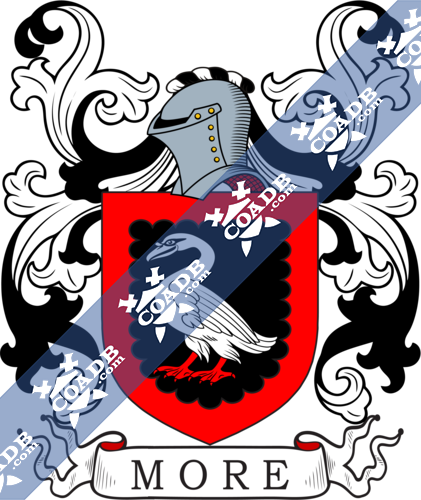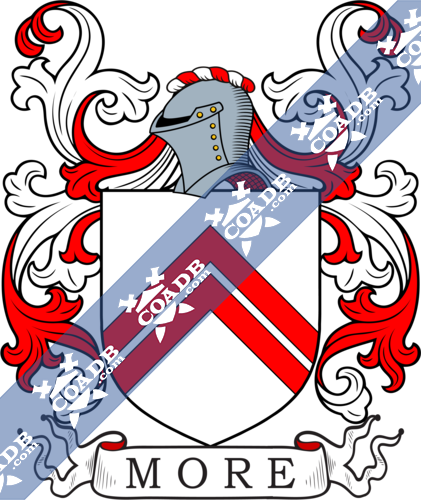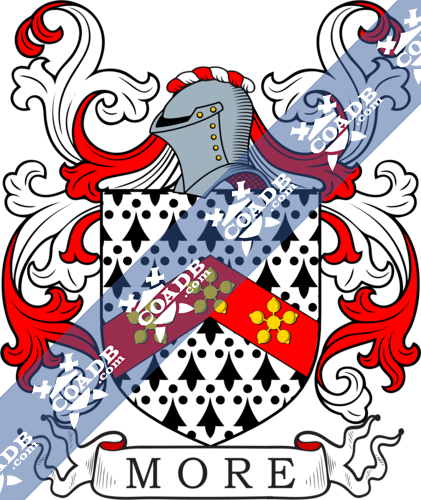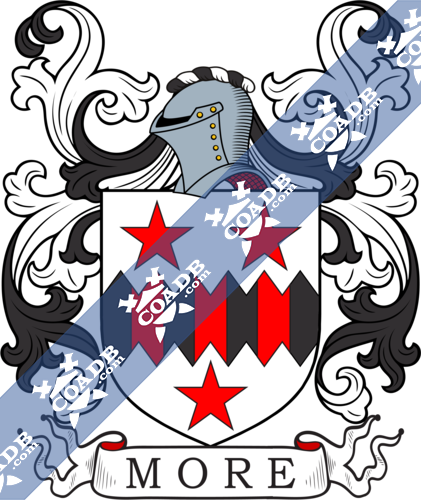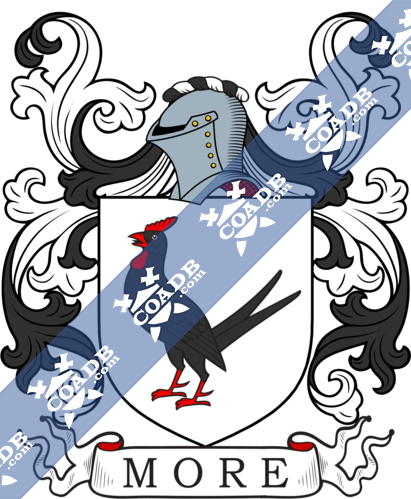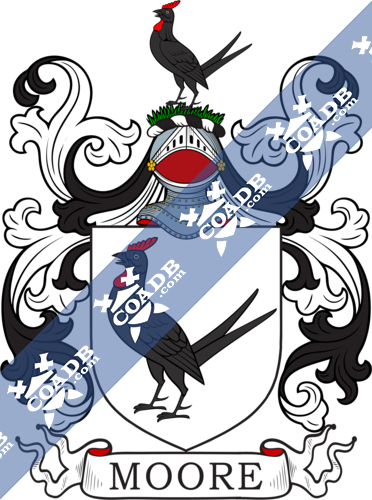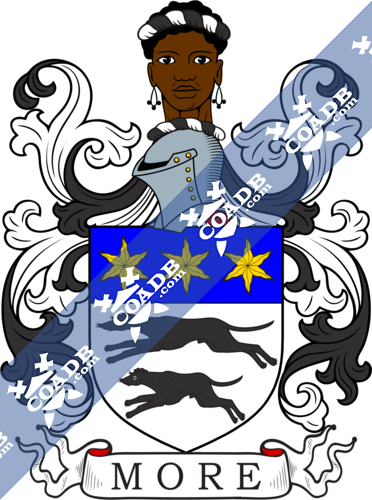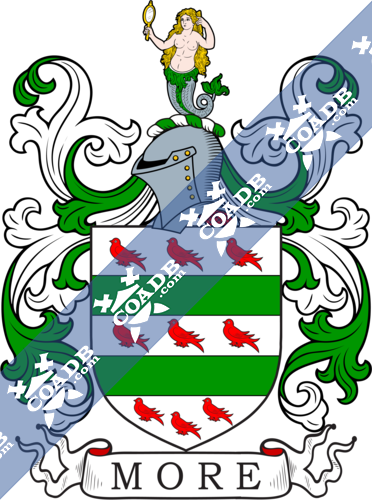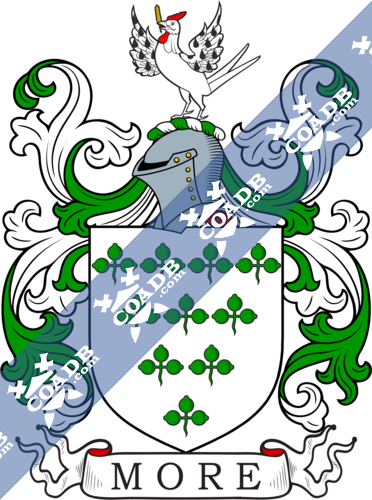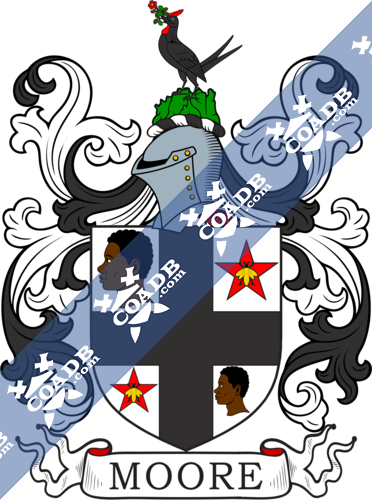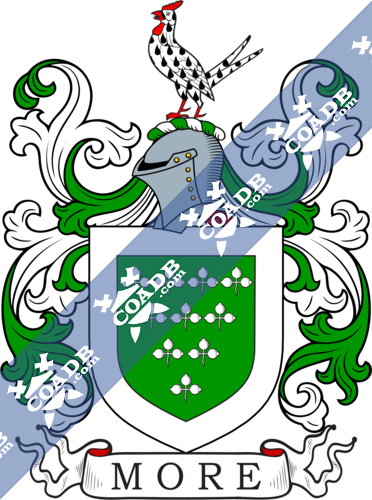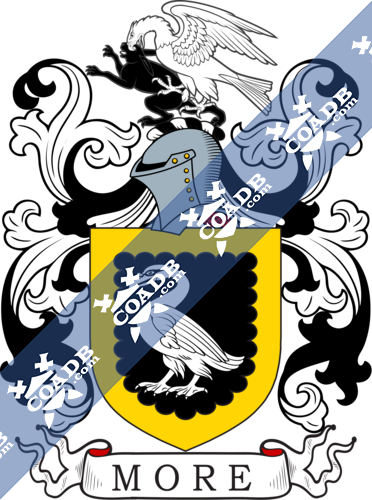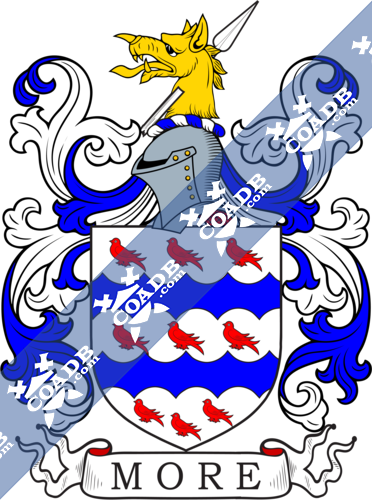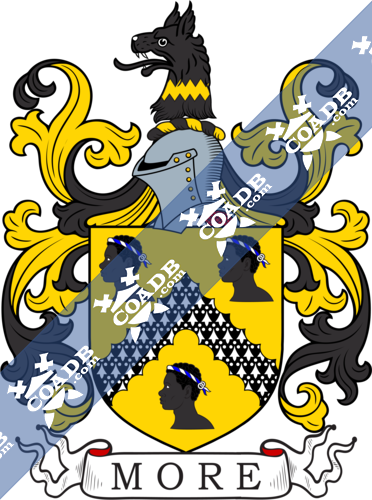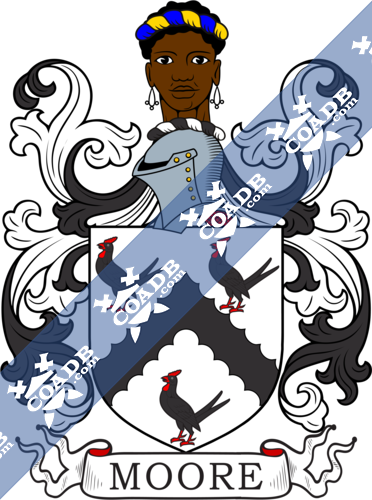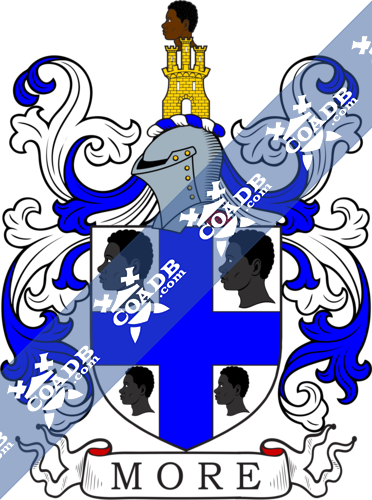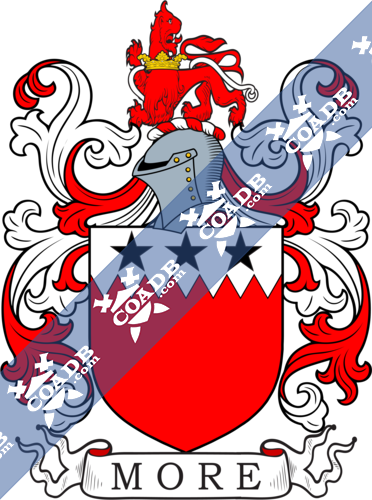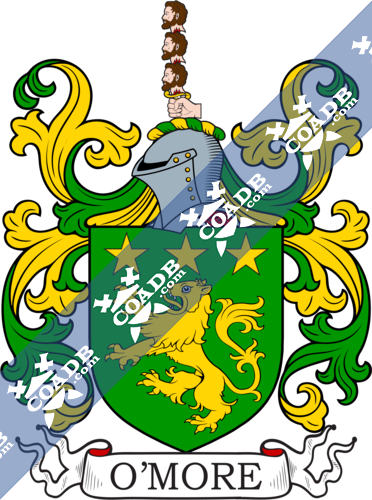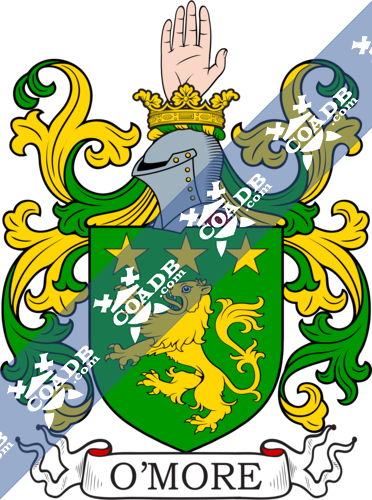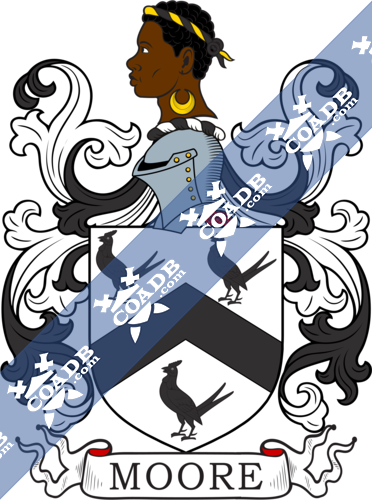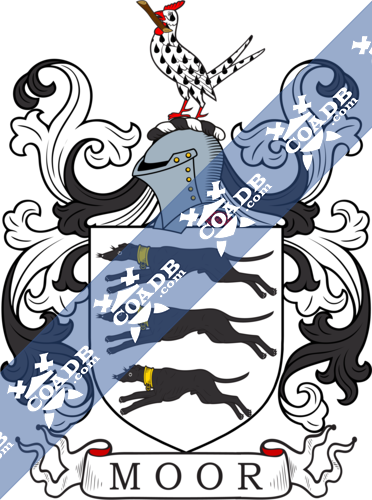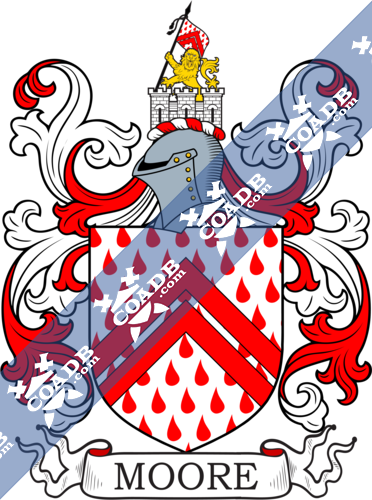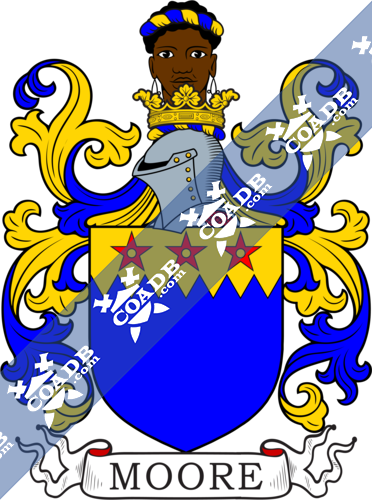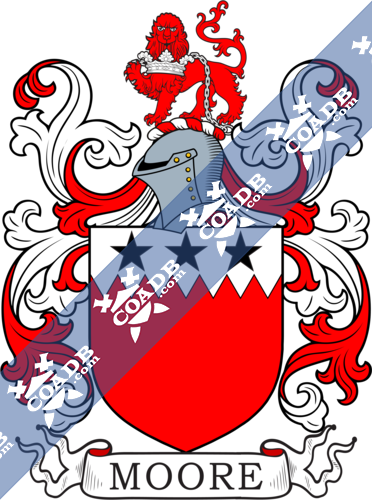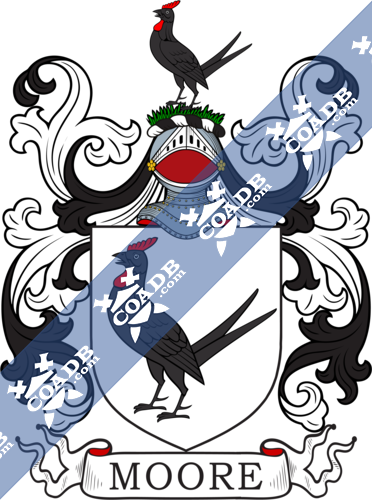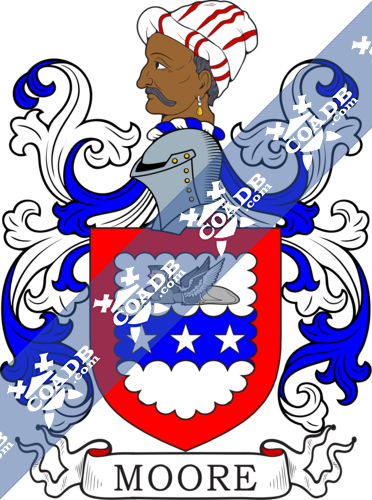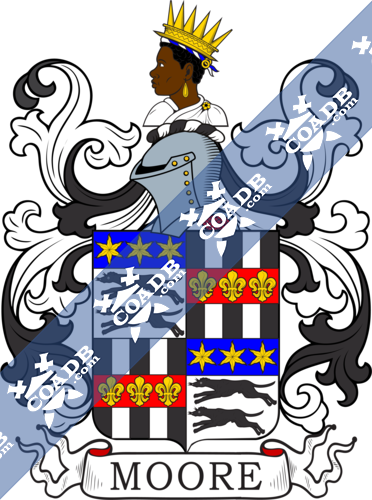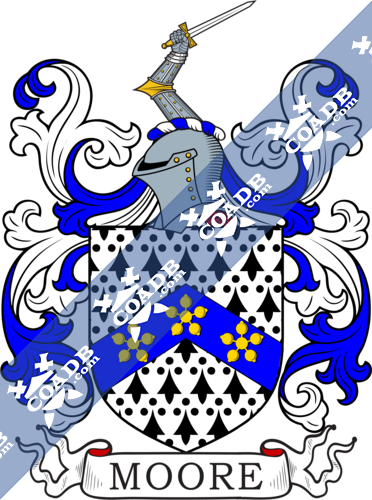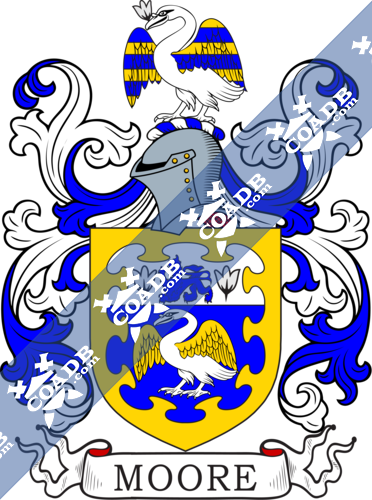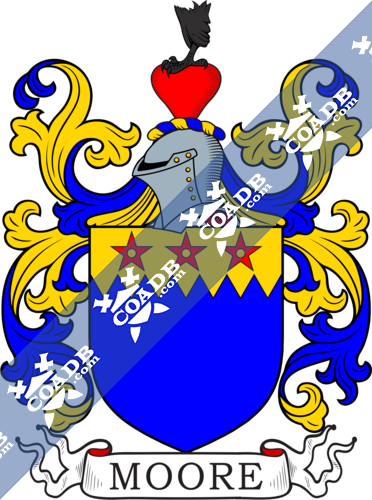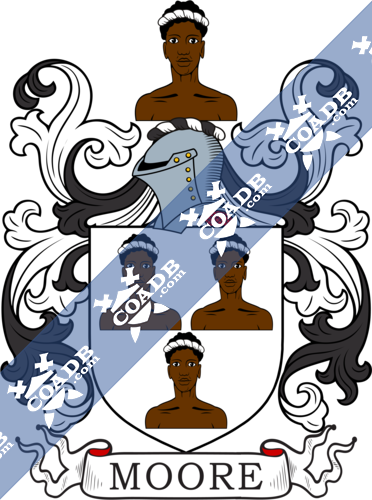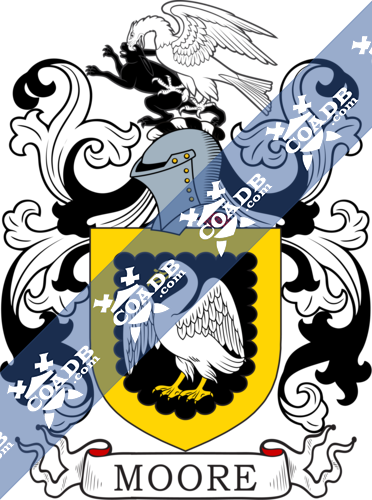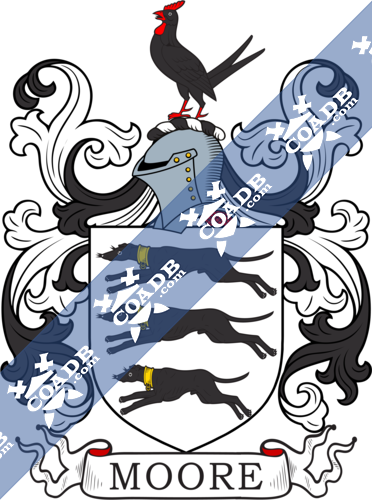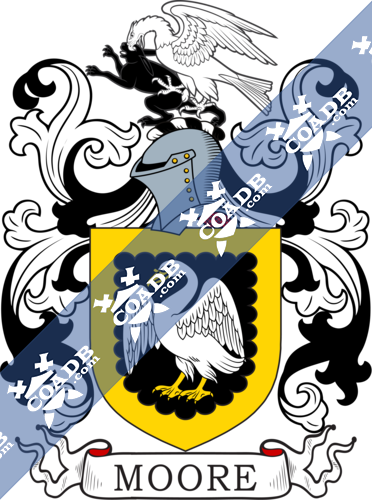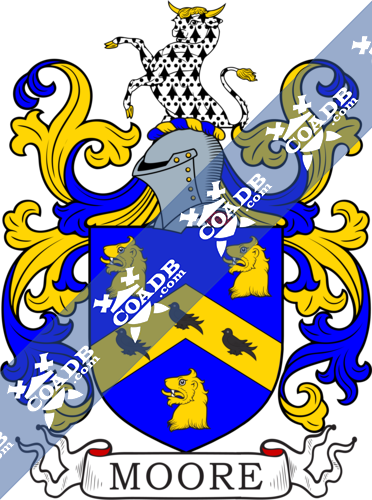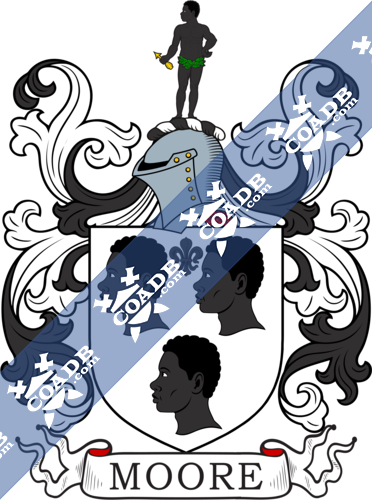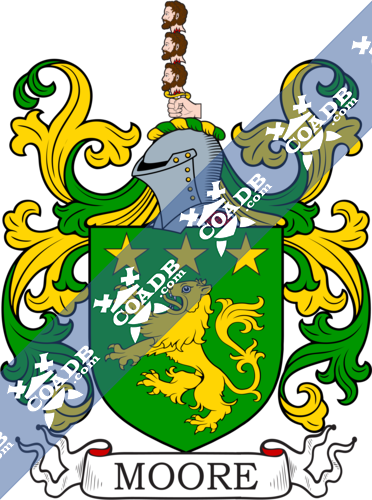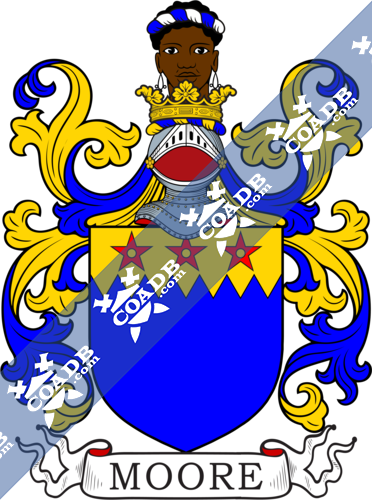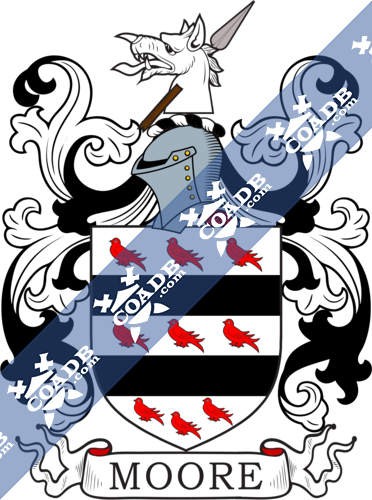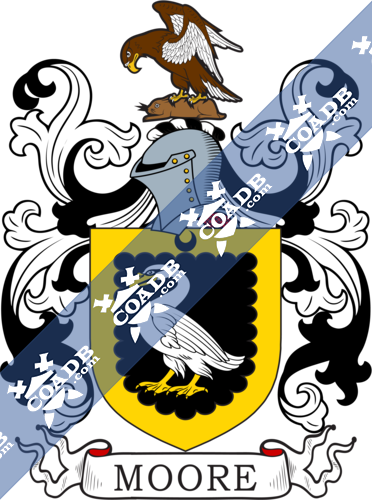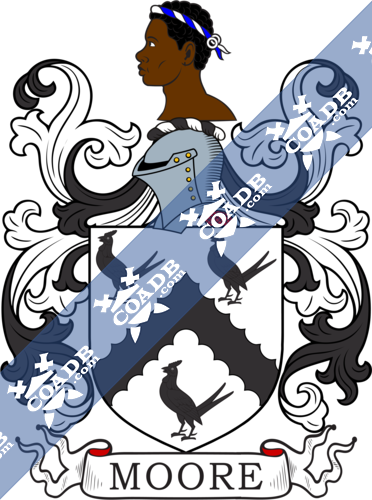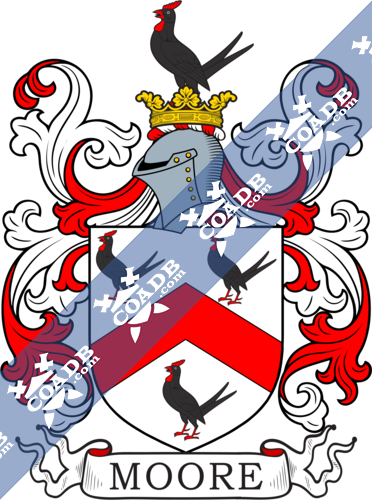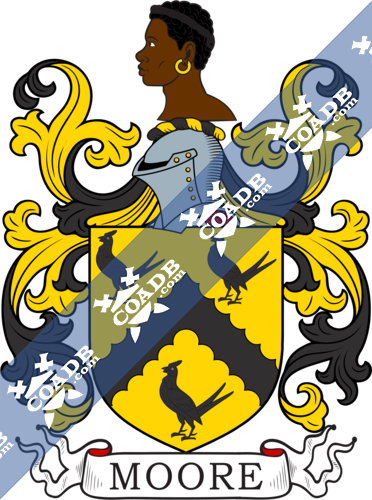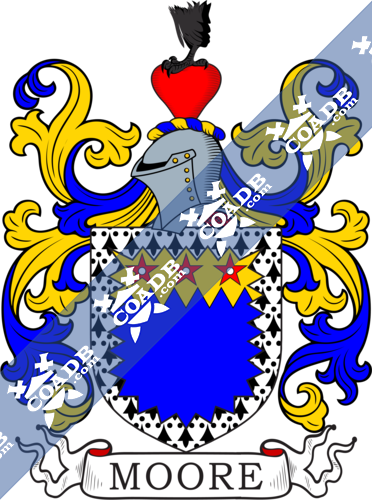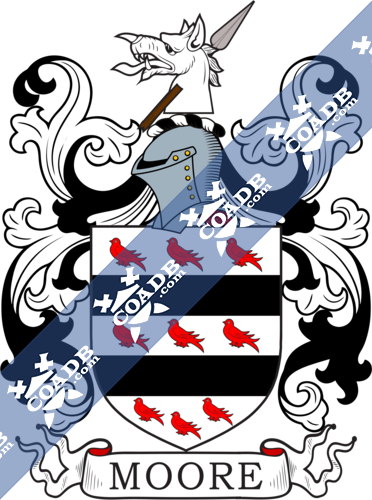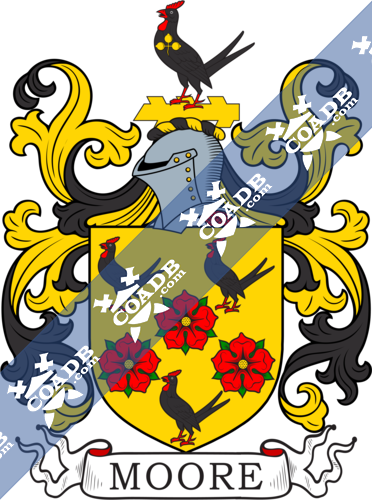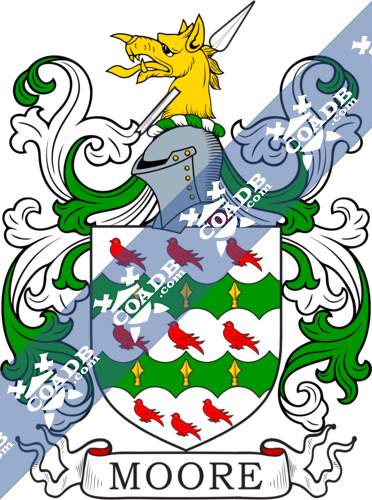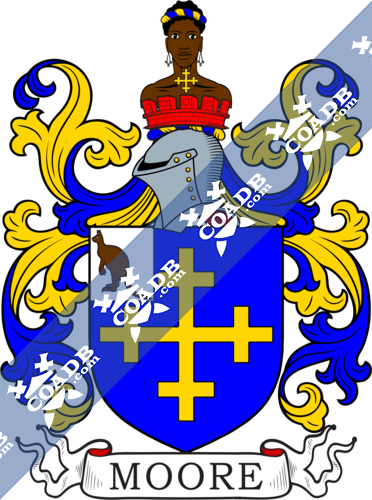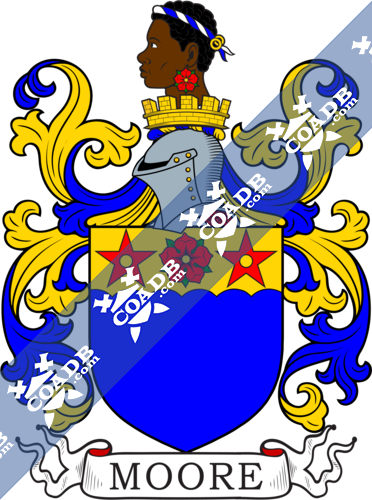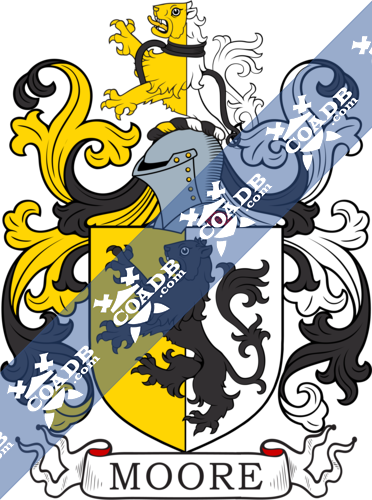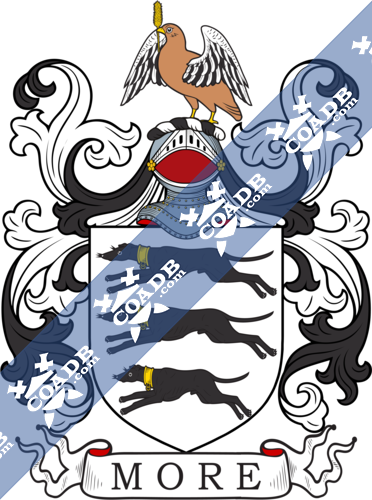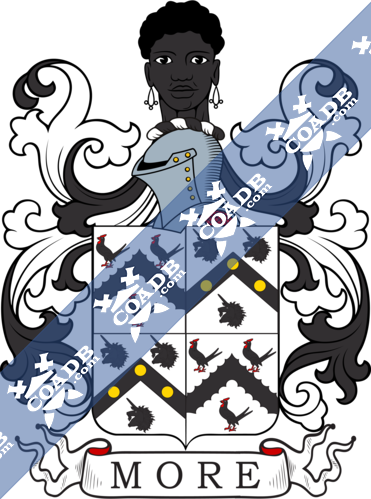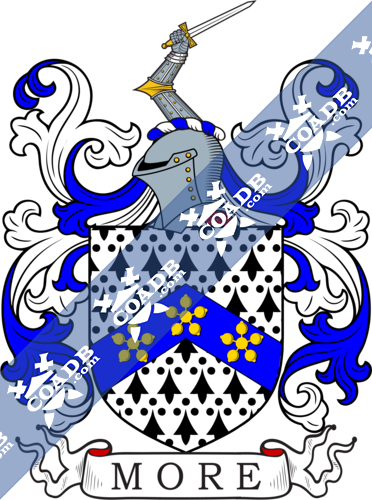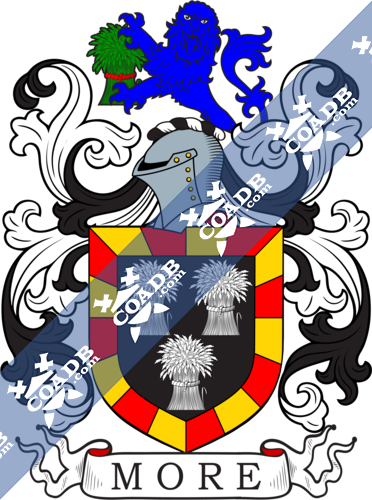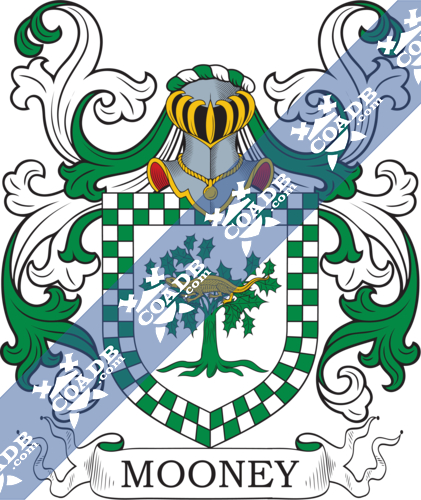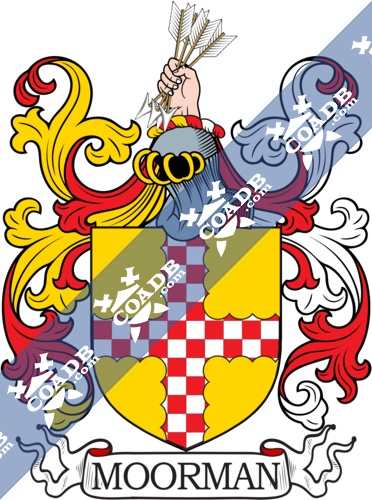Moore Family Crest, Coat of Arms and Name History
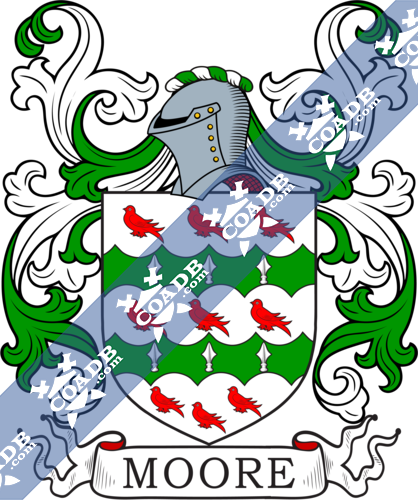
Moore Coat of Arms Gallery
Don’t know which Coat of Arms is yours?
We can do a genealogical research. Find out the exact history of your family!
Learn MoreSurname Name Meaning, Origin, and Etymology-1500
The name Moore is derived from the local ‘at the moor’, John o’ the Moor; or from residence near a boggy heath or moor, the Moorhouse; Mor, great, chief, tall, mighty, proud; or Moar, a collector of manorial rents in the Isle of Man. In the Old French, it refers to someone dark-skinned, or of dark and swarthy complexion.
In Ireland, the Gaelic O’Mordha was composed of the elements O’, meaning descendant of, and Mordha, meaning proud or stately. In Scotland and Wales, the Gaelic word mor meant a large man. In Welsh, Mowr meant great.
Spelling Variations
Common spelling variations of this last name include: Moor, Moore, More, Delamore, O’Moore, More, Mores, Moor, Moores, Moors, Mure, and in Scotland Muir. Ancient names would include De Mora, and Ad Moram
Early Bearers of the Surname
The earliest holders of the name include John atte Mor (1273), Adam atte More (1273), Fulco de la More (1273), and Agatha atte More (1327). First recorded in the late 11th Century, early records of the name include William Mor, a tax register known as the Feet of Fines for the county of Essex in 1198, and Matthew del More in 1275. Adam More or Moire, knight, witnessed charters by Robert Bruce in 1328, while Elizabeth Mure, daughter of Sir Adam Mure of Rowallan, became queen of King Robert II in 1347. In Scotland, Dovenal le Fitz Michel More de Levenaghes, rendered homage in 1296, as did Adam de la More and Renaud del More both of the County of Are.
History, Genealogy, and Ancestry
The first recorded spelling of the family name is William de More in 1086. Another early recorded spelling of the name was Thomas de la More in 1291, who was executor of the will of Dervorguilla de Balliol (an influential Scottish woman, mother of John I, who eventually became King of Scotland).
Early American and New World Settlers
Early settlers in America included Leonard Moore, who is recorded as “living at Elizabeth Cittee, Virginea” in 1624, having arrived on the ship “Bona Nova” in 1619. Also, Apollos Moore, born in England and immigrated to America. He settled in Rennselaerville and served in Revolutionary army. His son, Chester, married Mary Lester; whose son, Frank Apollos Moore, married Margaret E. Sipple, and served in the Rebel Army.
Mottoes:
The family mottoes include non civium ardor (not by the rage of the crowd)
Moor – Nihil utile quod non honestum – Nothing dishonest or dishonourable is useful
Moore – A more floresco – I (Moore) flourish according to my custom
Moore – Æquabiliter et diligenter – By consistency and diligence
Moore – Æqualiter et diligenter – Calmly and diligently
Moore – Animum rege – Rule thy mind
Moore – Dum spiro spero – While I have breath I hope
Moore – Duris non frangor – I am not disheartened by difficulties
Moore – Fortis cadere, cedere non potest – The brave man may fall, but cannot yield
Moore – Fortis cadere, non cedre potest – The brave man may fall, but cannot yield
Moore – I Deo confido – I trust in God
Moore – Nihil utile quod non honestum – Nothing dishonest or dishonourable is useful
Moore – Non civium ardor – Not the ardour of the citizens
Moore – Resolve well, persevere – Resolve well, persevere
Moore – Spectemur agendo – Let us be viewed by our actions
Moore – Vis unita fortior – Strength united is the more powerful
More – Comme je fus – As I was
More – Deus dabit – God will give
More – Major opima ferat – Let the more worthy carry off the honors
Notables
Famous people with the Muir last name include: 1) Thomas Muir (1765-1798), who founded a society for parliamentary reform (1792) 2) Sir Jonas Moore came to the attention of Charles II because of his mathematical knowledge. He was appointed surveyor-general of the ordnance where his responsibilities were to examine the ordnance received to see that it was of good quality, and the mapping of fortifications. Sir Jonas was a governor of Christ’s Hospital and convinced Charles to endow a school for mathematics. Sir Jonas compiled a 2 volume “General System of Mathematics,” which was published after his death. He was born about 1620 and died 1681 3) Sir John Moore, son of Dr. John Moore the physician, became a distinguished English general, after entering the army in his fifteenth year. Due to his father’s great influence, he was able to rapidly rise to the rank of Lieutenant colonel before ever having seen service. He eventually served with distinction in the West Indies, Ireland and Holland. He was wounded in Egypt after which he turned to training troops and was very successful. His regiments formed the famous light division of the Duke of Wellington’s army in the Peninsular War, which did such good deeds, proving the soundness of Moore’s teaching method. He eventually died in battle, a hero. He was born in 1701 and died in 1809 4) Sir Thomas More was a distinguished English statesman and writer, was the son of Sir John More, one of the judges of the King’s Bench. After attending Oxford, he obtained a seat in Parliament. When Henry VIII became king, he was, in 1508, appointed judge of the sheriff’s court in London, and eventually received knighthood and a place in the Privy Council, and eventually Chancellor. He converted to the Roman Catholic religion and believed strongly in the papal authority. This led him to deny the king’s supremacy as head of the church in England. He was sent to the Tower, tried, and condemned to death. He is the author of “Utopia”, where he lays out a perfect commonwealth on an imaginary island. Sir Thomas had four children. His eldest daughter, Margaret, married a man named Roper. Sir Thomas More was born on Milk Street, London in 1480 and was beheaded in 1535.
Blazons & Genealogy Notes
1) Moore – (Fawley, co. Berks, bart., extinct 1807; Sir Francis Moose, an eminent person temp. Queen Elizabeth, M.P. for Oxford, fifth in descent from Roger Moore, temp. Henry VI., d. 1621, leaving a son and heir, Henry Moore, Esq., of Fawley, created a bart. 1627). Ar. a moorcock sa. combed and wattled gu. Crest—On a tuft of grass vert a moorcock sa. combed and wattled gu. Motto—Nihil utile quod non honestum.
2) Moore – (Apple by-Parva, cos. Leicester and Derby, a manor purchased temp. Elizabeth, by Charles Moore, of Stretton, from Sir Edward Griffin, Knt.). Erm. three greyhounds courant sa. collared gu. on a canton of the last a lion pass. or. Crest—A moorcock sa. guttée d’or, the beak, comb, wattles, and legs gu. holding in the beak a branch of heath ppr. Motto—Non civium ardor.
3) Moore – (Grimeshill, co. Westmoreland; William Moore, Esq., was the only son of Lieut.-Col. Joun Moore, by Eliza, his wife, second dau. and co-heir of Richard Gathorne, Esq., of Kirkby Lonsdale, and fourth in descent from Giles Moore, Esq., of Grimeshill, a Deputy Lieutenant for co. Westmoreland, who m. Mary, second dau. and co-heir of James Cragg, Esq., of Dent, by Mary, his wife, second dau. and co-heir of John Middleton, Esq., the last male descendant of the very ancient family of Middleton, of Middleton). Or, on a chev. pean betw. three Moors’ heads in profile couped at the neck ppr. wreathed about the temples ar. and sa. a pheon of the field, quartering Cragg, Middleton, Bindlosse, and Gathorne. Crest—A swan, wings elevated ar. charged on the breast with a pheon sa. in front of bullrushes ppr. Motto—Animum rege.
4) Moore – (Apsley Guise, co. Bedford). Sa. a swan, wings expanded ar. membered or, within a bordure engr. of the third. Crest—An eagle ar. preying on a bare sa.
5) Moore – (Cookham, co. Berks, and Corbet, co. Salop). Sa. a swan, wings expanded ar. membered or, a bordure engr. of the third. Crest—An eagle ar. preying on a hare sa.
6) Moore – (cos. Devon, Hanta, and Surrey). Sa. a swan close ar. a bordure engr. or. Crest—Out of a ducal coronet az. a swan’s neck ar. beaked gu.
7) Moore – (Blandford Forum, co. Dorset). Or, three roses in chev. gu. barbed and seeded ppr. betw. as many moorcocks also ppr. Crest—A staff raguly fessways or, thereon a moorcocks ppr charged on the breast with a trefoil gold. Motto—Amore floresco.
8) Moore – (Northaston, co. Oxford; William Moore, alias Meredith, second son of John Moore, Esq., of Uppenwyld, co. Bucks, temp. Queen Elizabeth. Visit. Oxon, 1566). alias Meredith (co. Bedford). Per pale or and ar. a lion ramp. sa. Crest—A demi lion ramp. couped per pale or and ar. collared and lined sa.
9) Moore – (Looseley; Sheriff of Surrey, temp. Henry VIII.). Az. on across ar. five martlets sa.
10) Moore – (co. Somerset; sometime lords of the manor of Greinton and Mere). Ar. two bars engr. vert betw. nine martlets gu. each bar charged with a spear head erect ar.
11) Moore – (Langley Lodge, Gerard’s Cross, co. Bucks, and Liverpool). Ar. on a cross sa. betw. in the 1st and 4th quarters a negro’s head in profile ppr. and in the 2nd and 3rd a mullet gu. a bee volant or. Crest—On a mount vert a moorcock sa. in the beak a sprig of bramble slipped ppr. Motto: Aequabiliter et diligenter.
12) Moore – (Thelwall, co. Chester, 1636). Sa. a cross ar. Crest—A Moor’s head couped ppr. with a cap gu. turned up erm.
13) Moore – (Stockwell, co. Surrey). Ar. a chev. engr. betw. three moorcocks sa. combs, wattles, and legs gu. Crest—A Moor’s head affrontée ppr. wreathed round the temples az. and or, a jewel pendent in the cars ar. Molto—Resolve well, persevere.
14) Moore – (Frampton Hall, co. Lincoln). Quarterly, 1st, ar. a chev. engr. sa. betw. three moorcocks ppr.; 2nd, ar. on a chev. betw. three unicorns’ heads erased sa. as many bezants; 3rd, or, three lions ramp. gu., for Cresacre; 4th. per chev. sa. and or, three elephants’ heads erased counterchanged, for Saunders; 5th, erm. on a chev. sa. betw. two dragons’ heads erased ppr. in chief and a buglehorn of the second stringed gu. in base a griffin’s head couped betw. two buglehorns stringed or, for Tunnard (modern); 6th, az. a chev. betw. three demi griffins or, for Tunnard (ancient); 7th, sa. on a fesse cotised or, betw. three coneys courant ar. as many escallops of the field, for Coney; 8th, vert three escutcheons ar. each charged with a border engr. or, for Burrell. Crest—A Moor’s head affrontée ppr. wreathed round the temples az. and or, a jewel pendent in the ears ar. Motto—Disce mori mundo.
15) Moore – (Pendridge, co. Dorset). Ar. on a fesse betw. three moorcocks sa. as many mullets or.
16) Moore – (Canterbury). Ar. a chev. betw. three moorcocks sa. Crest—A Moor’s head sidefaced ppr. wreathed about the temples or and sa. on the neck a crescent for diff.
17) Moore – (Wellington, co. Hereford). Sa. a chev. betw. three fleurs-de-lis ar. a crescent for diff.
18) Moore – (Sandon and Haddon, co. Hertford, and London). Ar. guttée de sang two chevronels gu. Crest—A demi lion ramp. guard, or, issuing out of a demi castle ar. holding a tanner of the arms, the staff sa. (another bears the crest issuing out of a ducal coronet gu.).
19) Moore – (co. Kent). Per fesse indented or and az. three mullets in chief gu.
20) Moore – or More – (co. Kent). Az. on a chief indented or, three mullets pierced gu. Crest—Out of a ducal coronet or, a Moor’s head ppr. filleted round the temples az. and or, a jewel pendent in the ears ar.
21) Moore – (Bankill, co. Lancatter). Vert ten trefoils ar. four, three, two, and one.
22) Moore – (Grantham, co. Lincoln; granted 1635). Gu. on a chief indented ar. three mullets sa. Crest—A lion pass. guard. gu. ducally gorged and chained ar.
23) Moore – (co. Lincoln). Vairé gu. and erm.
24) Moore – (Lord Mayor of London, 1682). Erm. three greyhounds courant sa. and for augmentation, on a canton gu. a lion of England.
25) Moore – (Inner Temple, London; granted 28 April, 1569). Same Arms and Crest as Moor, Bart., ol Fawley, co. Berks.
26) Moore – (John Moore, Bishop of Norwich, 1691-1707, and Bishop of Ely, 1707-14). Erm. on a chev. three ciuquefoils ar.
27) Moore – (co. Oxford). Ar. a fesse indented componée sa. and gu. betw. three mullets of the last.
28) Moore – (The Moore, co. Salop). Per pale az. and ar. barry of twelve counterchanged.
29) Moore – (Ipswich, co. Suffolk). Ar. a fesse betw. three mullets az. Crest—A stag pass sa. platée, attired or.
30) Moore – (borne by the late Sir John Moore, K.B., the hero of Corunna; by James Carrick-Moore, Esq., of Corswall, co. Wigton; by Admiral Sir Graham Moore, K.C.B.; by Charles Moore, Esq., Barrister-at-law; and by Francis Moore, Esq., formerly Under Secretary at War; sons of John Moore, of Dovehill, M.D., the author of “Zeluco”). Ar. on a fesse engr. az. three mullets of the field, in chief a sphinx ppr. a bordure engr. gu. Crest—A Moor’s head couped at the neck, turban ppr.
31) Moore – (Edmund F. Moore, Esq., of Lincoln’s Inn, Barrister-at-law). Ar. two greyhounds courant in pale sa. on a chief az. three estoiles or, quartering sa. two pallets ar. on a fesse gu. three fleurs-de-lis or. Crest—A blackamoor’s head in profile ppr. the head encircled with a wreath ar. and az. and crowned with an Eastern coronet of six points, gold earrings, and vested in a white drapery fastened with a gold buckle on the shoulder. Motto—In Deo confido.
32) Moore – (Moorehayes, in Cullompton, co. Devon, temp. Henry III.; the last male heir, George Moose, Esq., d. in 1711; the heiress m. Blackmore). Erm. on a chev. az. three cinquefoils or. Crest—A dexter arm embowed ppr. holding a sword ar.
33) Moore – (Wichford, co. Hants. Visit. 1634). Ar. two bars vert betw. nine martlets gu. three, three, and three. Crest—A mermaid ppr. hair, mirror, and comb or.
34) Moore – (Newington, co. Surrey, 1576). Az. on a chev. betw. three lions’ heads erased or, as many martlets sa. Crest—A demi bull saliant erminois, attired sa.
35) Moore – (co. Wilts). Az. three leopards’ faces or.
36) Moore – (Barwick, St. John, co. Wilts). Erm. on a chev. betw. three Moors’ heads couped sa. two swords in saltire ar.
37) Moore – (granted to William Cameron Moore, Esq., of Manchester, and of Bamford, co. Derby). Az. a swan ar. wings elevated or, a border nebuly of the last, on a chief of the second a lion pass. of the first betw. two flowers of the cotton tree slipped ppr. Creat—A swan ar. wings elevated barry of six or and az. holding in the beak a flower of the cotton tree, as in the arms. Motto—Mores hoc mutato.
38) Moore – Az. on a chief indented or, three mullets pierced gu. Crest—On a human heart gu. an eagle’s leg erased at the thigh sa. Another Crest—Out of a ducal coronet or, a Moor’s head and shoulders in profile sa. wreathed about the temples.
39) Moore – Ar. three Moors’ heads couped at the shoulders ppr. wreathed about the temples of the field. Crest—A Moor’s head, as in the arms.
40) Moore – Ar. a chev. sa. betw. three fleurs-de-lis gu. a pile of the second.
41) Moore – (Rev. Walter Moore). Ar. three greyhounds courant in pale sa. collared or. Crest—A moorcock ppr. Motto—Dum spiro spero.
42) Moore – Gu. a fesse betw. three boars’ heads sa.
43) Moore – Ar. two bars az. betw. nine martlets vert, three, two, and one.
44) Moore – Ar. ten martlets sa.
45) Moore – Gu. three text S’s or.
46) Moore – Ar. a fleur-de-lis betw. three Moors’ heads sa.
47) Moore – Sa, a swan ar. within a bordure engr. or.
48) Moore – Ar. a fesse gu. betw. six moorcocks sa. beaked and legged of the second.
49) Moore – Erm. on a chev. az. three cinquefoils or.
50) Moore – Az. on a chev. betw. three lions’ heads erased or, as many martlets sa. Crest—A demi bull erm. armed or.
51) Moore – Ar. on a chev. sa. betw. three blackamoors’ heads in profile, couped of the second, clothed on the shoulder gu. two swords, the points crossing each other of the first, hilts and pommels or.
52) Moore – Ar. three Moors’ heads in profile couped sa. a fleur-de-lis in chief. Crest—A naked man sa, holding a dart or.
53) Moore – or More – (Balyna, co. Kildare; descended from O’More; Letitia, dau. and heir of James Moore, Esq., of Balyna, m. Richard O’Ferrall, Esq., of Ballyree, co. Longford, and d. 1778). (Cremorgan, in the Queen’s co.; descended from Mortogh Oge O’More, of Cremorgan, d. 1580). (granted to John Mulcail, Esq., of the city of Dublin, by Hawkins, Ulster, 1770, upon his taking the surname of Moore, on a claim that lie was descended from John Moore, or More, son of Rory O’More, last Lord of Leix, who was called Mulcaugho, and whose descendants called themselves Mulcail) Motto—Semper fidelis et audax. Vert a lion ramp. or, in chief three mullets of the last. Crest—A hand lying fessways, couped at the wrist, holding a sword erect, impaling three gory heads all ppr. Mottoes—Conlan a-bu; and, Spea mea Deus.
54) Moore – (Moore Place, and Benenden, co. Kent; descended from Thomas de la More, who held the manor of Moore Place, or Moore Court, in Ivy Church, co. Kent, temp. Henry II.; his representative, temp. Henry VIII., John Moore, Esq., of Benenden, co. Kent, m. Margaret, dau. of John Brent, and cousin and heir of Robert Brent, Esq., of Wellsborough, and had six sons, viz., 1) Owen, d. s. p.; 2) Sir Edward, ancestor of the Marquess of Drogheda; 3) George d.s.p; 4) Sir Thomas, ancestor of Moore, of Croghan, and the extinct Earl of Charleville; 5) Nicholas, 6) Brent, ancestor of Moore, of co. Louth). Az. on a chief indented or, three mullets pierced gu.
55) Moore – (Earl and Marquess of Drogheda; descended from Sir Edward Moore, Knt., eldest surviving son of John Moore, Esq., of Benenden). (Ballyhale, co. Kilkenny, Moorfield, co. Kildare, &c; descended from Hon. Ponsonby Moore, second son of Edward, fifth Earl of Drogheda). Same Arms. Crest—Out of a ducal coronet or, a Moor’s head ppr. wreathed about the temples ar. and az. Supporters—Two greyhounds ar. Motto—Fortis cadere cedere non potest.
56) Moore – (Kersant, co. Berks, bart., extinct; Admiral Sir John Moore, son of Hon. and Rev. Henry Moore, third son of Henry, third Earl of Drogheda, was created a bart. 1766, and a Knight of the Bath 25 June, 1772, d. s.p.m.). Same Arms, Crest, and Motto. Supporters—Two greyhounds reguard. ar. each supporting with the exterior foot an anchor sa.
57) Moore – (Croghan, King’s co.; descended from Sir Thomas Moore, Knt., second surviving son of John Moobe, Esq., of Moore Place, and Benenden, co. Kent; Fun. Ent. Ulster Office, 1633, Sir John Moore, Knt., of Croghan). Same Arms and Crest, a crescent for fiff.
58) Moore – (Earl of Charleville, extinct 1761; John Moore, Esq., of Croghan, was created Baron Tullamore, 1715; his son and successor was raised to an earldom 1758). Same Arms and Crest, a crescent for diff. Supporters—Two blackamoore attired az. wreathed about the temples of the last and or, each holding in the exterior hand a dart ppr. Motto—Fortis cadere cedere non potest.
59) Moore – (co. Louth; descended from Brent Moore, sixth son of John Moore, Esq., of Benenden, co. Kent; Fun. Ent. Ulster’s Office, 1684, Thomas Moore, eldest son of Col. Brent Moore). Same Arms, a crescent for diff.
60) Moore – (Ross Carberry, co. Cork). (Tara House, co. Meath, and Tullyhallen, co. Louth; descended from John Moore, of Dublin, who purchased land in co. Louth 1721). Motto—Durum patientia frango. Ar. two bars sa. betw. nine martlets gu. Crest—An heraldic tiger’s head couped ar. pierced through with a broken spear ppr.
61) Moore – (Earl of Mountcashell; descended from Stephen Moore, Esq., of Kilworth, eldest son of Richard Moore, Esq., co. Salop, who settled at Clonmell, temp. James I.). Sa. a swan ar. membered and beaked or, a border engr. of the last. Crest—A goshawk, wings addorsed, preying on a coney all ppr. Supporters: Dexter, a leopard; sinister, a rhinoceros, both ppr. collared and chained or. Motto—Vis unita fortior.
62) Moore – (Barne, co. Tipperary; descended from Thomas Moore, second son of Richard Moore, Esq., co. Salop). Same Arms, Crest, and Motto, a crescent for diff.
63) Moore – (Mooresfort, co. Tipperary; Emily, dau. and heiress of Maurice Crosbie Moore, Esq., of Mooresfort, m. 1841, Lord Cecil Gordon, fifth son of George, ninth Marquess of Huntley). Ar. a chev. engr. betw. three moorcocks sa. Crest—A Moor’s head and shoulders in profile ppr. wreathed about the temples ar. and az.
64) Moore – (Gordon-Moore; exemplified to Lord Cecil Gordon and Emily Moore, his wife, dau. of Maurice Crosbie Moore, Esq., of Mooresfort, co. Tipperary, on their assuming, by royal licence, 1850, the additional surname and arms of Moore). Quarterly, 1st and 4th, ar. a chev. engr. betw. three moorcocks sa., for Moore; 2nd and 3rd, az. three boars’ heads couped, two and one or, for Gordon. Crests—1st: A Moor’s head and shoulders in profile ppr. wreathed about the temples ar. and az., for Moore; 2nd: A stag’s head couped ppr. corned or, for Gordon. Motto—Audaces fortuna juvat.
65) Moore – (Ballina, co. Mayo, and Alicante, in Spain; allowed by Hawkins, Ulster, 1773, to George Moore, of Alicante, great-grandson of George Moore, Esq., of Ballina, who was son of Thomas Moore, Esq., of Barenburgh, co. York). Ar. a chev. gu. betw. three moorcocks ppr. Crest—On a ducal coronet or, a moorcock ppr. Motto—Fortis cadere cedero non potest.
66) Moore – (Moore Hall, co. Mayo). Or, a chev. engr. betw. three moorcocks sa. Crest—A Moor’s head and shoulders ppr. in the ear a ring or. Motto—Fortis cadere cedere non potest.
67) Moore – (Moigne Hall, co. Cavan; Reg. Ulster’s Office, to Nicholas Moore, captain in the regiment of Col. Robert Tothill, sent to Ireland by the Parliament, 1649). Az. on a chief indented or, three mullets gu. pierced ar. a border indented erm. Crest—An eagle’s leg erased a la quise sr.. grasping a human heart gu.
68) Moore – (Col. Moore, one of the officers sent to Ireland by the Parliament, 1649). Vert ten trefoils slipped ar. four, three, two, and one.
69) Moore – (Rosscarberry, co. Cork). Ar. two bars sa. betw. nine martlets gu. Crest—An heraldic tiger’s head couped ar. pierced through with a broken spear ppr.
70) Moore – (Drogheda; Reg. Ulster’s Office). Barry of six ar. and aa. a lion ramp. gu.
71) Moore – (Barmeath and Carblagh, co. Meath; Fun. Ent. Ulster’s Office, 1614, Patrick Moore, of the latter place, son of Bartholomew Moore, who was second son of Moore, of Barmeath). Sa. two bars ar.
72) Moore – (impalement Fun. Ent. 1667, Ulster’s Office). Ar. a chev. betw. three Moor’s heads in profile couped at the neck sa.
73) Moore – (certified to John Moore, Esq., of Bristol, son of John Moore, of Bristol and of Ireland). Ar. two bars engr. vert, each charged with a spear’s head or, betw. nine martlets, three, three, and three gu. Crest—A tiger’s head erased or, thrust through the neck with a broken spear ar. Motto—Fortis cadere cedere non potest.
74) Moore – (Moore Fort, co. Antrim; confirmed to William Moore, Esq., and to the descendants of his grandfather). Az. on a chief engr. or, an annulet betw. two mullets gu. Crest—Out of a mural crown ppr. charged with an annulet gu. a Moor’s head in profile also ppr. the temples encircled with a wreath ar. and az. Motto—Fortis cadere cedere non potest.
75) Moore – (granted to Charles Moore, Esq., of Coogee, Sydney, New South Wales, Mayor of that city, 1867-9, son of James Moore, of Ballymacarue, co. Cavan). Az. a cross crosslet or, on a canton ar. a kangaroo ppr. Crest—Out of a mural crown gu. a Moor’s head couped at the shnulders ppr. on the neck a cross crosslet gold, and round the temples’ a wreath or and az. Motto—Perseverando et cavendo.
76) Moore – (granted to Charles Moore, Esq., of Mooresfort, co. Tipperary). Az. on a chief engr. or, a rose gu. barbed and seeded ppr. betw. two mullets pierced of the third. Crest—Out of a mural crown ppr. a Moor’s head also ppr. wreathed about the temples ar. and az. and charged on the neck with a rose gu. barbed vert. Motto—Fortis cadere cedere non potest.
77) Moore – (represented by Foljambe). Ar. on a chev. indented betw. three moor cocks sa. as many pallets or, each charged with a fleur-de-lis of the second.
78) More – (co. Bedford). Per saltire or and ar. in pale two moorcocks, in fesse as many escallops sa.
79) More – Ar. a fesse dancettee paly of six sa. and gu. betw. three mullets of the second.
80) More – (co. Bedford). Ar. two bars betw. nine martlets gu.
81) More – (More Hall and Bank Hall, co. Lancaster, bart., extinct 1810: a family of great antiquity, of which was Sir William De La More, made a knight banneret by the Black Prince at Poictiers. Sir Edward More, of More Hall, was created a bart. in 1675, a title which expired in 1810 with his grandson, Sir William More, whose only dau. and heir, Elizabeth, m. in 1795, Charles Browning, Esq., of Horton Lodge, co. Surrey). Ar. three greyhounds courant in pale sa. collared or. Crest—A partridge, wings expanded ppr. in the mouth a stalk of wheat of the last. Motto—Comme je fus.
82) More – (Sir Thomas More, the eminent Lord Chancellor, temp. Henry VIII.; his only son, John More, was ancestor of the Mores, of Barnborough, co. York; his dau. Margaret, m. William Roper, Esq., of Eltham, co. Kent). Ar. a chev. engr. betw. three moorcocks sa. combs, wattles, and legs gu., quartering ar. on a chev. betw. three unicorns’ heads erased sa. as many bezants. Crest—A Moor’s head affrontee sa.
83) More – (co. Cambridge). Gu. a cross pattee ar. in chief an escallop of the second.
84) More – (co. Chester). Erm. a fesse gu. betw. five (another, six) moorcocks ppr.
85) More – (co. Chester). Ar. a fleur-de-lis betw. three Moors’ heads couped ppr.
86) More – (co. Chester). Ar. a Moor’s head couped betw. three fleurs-de-lis sa.
87) More – (co. Derby). Ar. a chev. betw. three Moors’ heads couped sa.
88) More – (Broadclist, co. Devon; Rev. John More, a minister, son of John More, who came to England 1561, and d. 1591, claimed and registered a descent from the Irish Sept of MacMurrogh. Visit. Devon, 1620). Sa. three garbs ar. a border gobony or and gu. Crest—A demi lion ramp, guard. az. holding betw. the paws a garb vert banded gu.
89) More – or Moore – (St. Colis More, co. Devon; descended from John More, to whom the Vicar of Broadwoodwiger made a deed of release 7 Henry VIl., 1491. Visit. Devon, 1620). Ar. a chev. betw. three moorcocks sa. crested gu.
90) More – or Moring – (Mooretown and Little Torrington, co. Devon; Anthony de la More, alias Moring, b. 1590, descended from Thomas de la More, grantor in a deed dated at La More, Wednesday next before the feast of St Agatha the Virgin, 12 Edward II., 1318. Visit. Devon, 1620). Ar. six martlets sa. three, two, and one.
91) More – or Moore – (Moore Hayes, co. Devon; John More, son of Humphry Mobe, by Mary, his wife, dau. of Richard Bamfylde, Esq., of Poltimore, same co., the sixth in descent from John More, or Moore, of Moore Hayes. Visit. Devon, 1620). Erm. on a chev. az. three cinquefoils or. Crest—An arm embowed holding in the hand a sword all ppr. pommel and hilt or.
92) More – (co. Devon). Sa. a swan ar. membered gu. a border engr. of the second.
93) More – (co. Devon). Ar. two chev. gu.
94) More – (co. Devon). Erm. on a chev. gu. three cinquefoils or.
95) More – Ar. a fesse dancettee gobony sa. and gu. betw. three mullets of the third.
96) More – De La More – (co. Oxford; arms in Brampton Church. Visit. Oxon, 1574). Ar. a fess dancettee gobony gu. and sa. betw. three mullets of the second (another, in Bicester Church, sa.)
97) More – or Moore, or Atmore – (Braye, co. Oxford, temp. Edward III. ; quartered by the descendants of Thomas Pury, servant to Henry IV., who m. Maud, dau. of William Atmore. Visit. Oxon, 1566). Or, a chev. gu. betw. three martlets sa.
98) More – (Burfield, co. Oxford; Richard More, temp. Henry VIII., whose dau. and heir to. John Doyley, Esq., of Stodhampton, same co. Visit. Oxon, 1634). Ar. a moorcock sa. combed and wattled gu.
99) More – or Moore – (Brodclift, co. Dorset). Sa. three garbs ar. two and one, a border gohony or and cu. Crest—A demi lion ramp. guard. az. holding betw. the paws a garb vert banded gu.
100) More – (Barking, co. Essex). Ar. a cock gu. armed, jelloped, and membered or.
101) More – (co. Essex). Ar. a fesse sa.
102) More – (cos. Essex, Lincoln, and Stafford, and London; confirmed 14 July, 1593). Aг. two greyhounds courant sa. on a chief az. three estoiles or. Crest—A Moor’s head ppr. wreathed ar. and sa.
103) More – (France). Or, a saltire betw. four martlets gu.
104) More – (co. Hants). Ar. on a fesse betw. three moorcocks sa. as many mullets or, an annulet of the last.
105) More – (cos. Hants and Somerset). Ar. two bars vert betw. nine martlets gu. three, three, and three. Crest—A mermaid ppr.
106) More – (co. Lancaster). Ar. ten trefoils slipped gu. (another, sa.) four, three, two, and one; another,
107) More – (co. Lancaster). Vaire erm. and gu.
108) More – (co. Lancaster). Ar. three greyhounds courant in pale sa. collared or.
109) More – or Moore – (Buckhall, co. Lancaster). Ar. Ten trefoils slipped vert, four, three, two, and one (another, a canton gu.). Crest—A moorcock ar. wings expanded guttee de poix, combed and wattled gu. in the beak an ear of wheat or.
110) More – or De la More – (co. Leicester). Sa. a cross ar.
111) More – (co. Leicester). Or, a fesse dancettée gu. in chief three martlets sa.
112) More – (Sixill, co. Lincoln). Ar. a fesse dancettée betw. three mullets sa.
113) More – (Lord Mayor of London, 1395). Ar. a fesse dancettée paly of six gu. and sa. betw. three estoiles pierced of the third.
114) More – (London, 1634). Vert ten trefoils slipped, four, three, two, and one, ar. a border of the last. Crest—A moorcock ar. gutte de poix, beaked and legged gu.
115) More – (London). Ar. a fesse dancettee gobony gu. and sa. betw. three estoiles pierced of the third.
116) More – (London). Az. on a chev. engr. or, three martlets sa. in chief a lion’s head erased of the second.
117) More – (London). Ar. a chev. engr. betw. three moorcocks sa.
118) More – (co. Norfolk). Ar. a bend engr. gu. cotised sa.
119) More – (Wallerton, co. Norfolk). Gu. a fesse betw. three boars’ heads couped ar.
120) More – (Norwich). Gu. a fesse betw. three boars’ heads couped ar. armed or, each having in the mouth a bezant.
121) More – (Kittington, co. Nottingham). Sa. a cross ar. Crest— A Moor’s head in profile ppr. on the head a chapeau gu. turned up erm.
122) More – (Larden Hall, co. Salop ; descended from Richard de More, of More, co. Salop, temp. King John). (Linley, co. Salop; descended from Larden; Rosert Bridgeman More, Esq., of Linley, Sheriff co. Salop, 1822, was eldest son of Robert Mobe, Esq., of Linley, the second son of Robert More, Esq., M.P., of Larden). Sa. a swan close ar. a border engr. or. Crest—An eagle ar. preying on a hare sa.
123) More – (co. Salop). Paly of six or and sa. over all a bend gu.
124) More – (Loseley, co. Surrey, bart., extinct 1684, originally from co. Derby; descended from Sir Christopher More, Knt., King’s Remembrancer in the Exchequer, who purchased the manor of Loscley, and d. in 1549. Sir Poynings More, M.P., of Loseley Hall, was created a baronet in 1642, but his son, Sir William More, of Loseley, dying s.p. in 1684, the title became extinct. The heiress of the family, Margaret, sister and heiress of Robert More, Esq., of Loseley, nephew of the first baronet, m. Sir Thomas Molyneux, Knt.). Az. on a cross ar. five martlets sa. Crest—On a ducal coronet ar. an antelope of the last.
125) More – (Taunton, co. Somerset, and Heytesbury, co. Wilts). Ar. two bars engr. az. betw. nine martlets gu. three, three, and three. Crest—A tiger’s head erased ar. pierced through the neck with a broken spear or, headed of the first.
126) More – (co. Somerset). Ar. two bars az. on each as many martlets of the first.
127) More – (co. Suffolk). Or, a chev. engr. ermines betw. three Moors’ heads couped at the shoulders sa. wreathed about the temples ar. and az. the ends of the wreath tied in knots. Crest—A wolf’s head erased sa. gorged with a collar dancettée or.
128) More – (co. Suffolk). Or, a chev. engr. ermines, in chief a Moor’s head full-faced, couped at the shoulders sa.
129) More – (co. Suffolk). Ar. a fesse az. in chief a mullet of the second.
130) More – (co. Suffolk). Ar. two bars engr. the first sa. the second az. betw. nine martlets gu. three, three, and three.
131) More – (The Priory, Taunton, co. Somerset; in 1550, Henry VIII. granted the Priory of Taunton to Mathew Colhurst, who sold it to Thomas More, Esq., descended from More, of Bayborongh. In the chancel of St. Mary Magdalene is a table monument to his memory, with this inscription:—”Thomas More, of the Pryory of Taunton, Esquyer, hear lying, departed this lyfe the 28th day of March, Anno Dini 1596, and had two wyfes; by the first he left lyving Robert, Gefrey, Francis, Johan, by the second Jespe and Florence, and blest them all”). Ar. two bars engr. az. betw. nine martlets gu. three, three, and three. Crest—A tiger’s head erased ar. pierced through the neck with a broken spear or, beaded of the first.
132) More – (Newington, co. Surrey). Az. on a chev. ar. three martlets sa. in chief a lion’s head erased or.
133) More – (Morehouse, co. Sussex). A bend betw. two bucks’ heads cabossed.
134) More – (co. York). Erm. on a chev. betw. three Moors’ heads couped sa. two swords conjoined in point ar. hilts or. Crest—A demi Moor ppr. holding with both hands a sword ar. hilt or, reclining over the sinister shoulder.
135) More – (Angram Grange, co. York, 1665). Ar. a chev. sa. betw. three heathcocks of the second, crested and wattled gu. Crest—A Moor’s head in profile sa. wreathed round the temples gu. and ar.
136) More – (co. York). Ar. a fesse dancettée gobony gu. and sa. betw. three mullets of the third.
137) More – (co. York). Ar. a cross az. betw. four Moors’ heads couped sa. Crest—On a tower triple-towered or, a Moor’s head in profile ppr.
138) More – Gu. a maunch erm.
139) More – Ar. two bars betw. nine martlets vert, three, three, and three.
140) More – Per chev. or and sa. a chev. engr. erm. in chief a moor’s head full-faced couped of the second, wreathed about the head ar.
141) More – Ar. a chev. betw. three unicorns’ heads erased sa. in chief as many hurts.
142) More – Or, three palets gu.
143) More – Sa. on a cross ar. five negroes’ heads couped ppr.
144) More – Az. three leopards’ faces or.
145) More – Ar. a chev. and pile sa. counterchanged of the field betw. three fleurs- de-lis of the second.
146) More – Ar. a bend engr. gu. cotised sa.
147) More – Gu. on a chief dancettée ar. three mullets sa. Crest—A lion pass. reguard. gu. ducally gorged and lined ar.
148) More – (Reg. Ulster’s Office). Ar. a fess sa.
149) O’More – (The O’More, Lord of Laoighis, or Leix, an extensive territory comprising the eastern and southern baronies of the present Queen’s co.; the territory was so called from the tribe designation of the Sept, Mac Laoighis, a name derived from their ancestor, Laoiseach, son of Conal Cearnach, Chief of the Craehbruadh, or Red Branch of Ulster; Mordha, the descendant of Laoiseach, was Lord of Laoighis, and from him derived the surname O’More. Rory O’More, Lord of Leix, temp. Queen Elizabeth, waged war against Her Majesty, and was slain in rebellion, 1578. Anthony, or Owny, O’More, his son, s. as Lord of Leix, but was alain in rebellion, 1601, when all the estates were forfeited and the Sept scattered). (Cremorgan, Queen’s co.; descended from O’More, Lord of Leix. Mortoge Oge O’More, of Cremorgan, d. 1580, leaving a son and heir, Lysagh O’More, of Cremorgan, who lefta son, Patrick O’More, his heir, in 1591). (Ballynakill and Stradbally, Queen’s co., and Lorraine; allowed by Hawkins, Ulster, 1774, to Charles O’More, Lord of Valmont, in Lorraine, son of Morogh O’More, Captain of Horse in the service of the Duke of Lorraine; descended from Edmond O’More, younger son of O’More, Lord of Leix). Vert a lion ramp. or, in chief three mullets of the last. Crest—A dexter hand lying fessways, couped at the wrist, holding a sword in pale, pierced through three gory heads all ppr. Motto—Conlan-a-bu. Motto—Semper fidelis et audax.
150) O’More – (Balyna, co. Kildare, now represented by More O’Ferrall; descended from O’More, Lord of Leix. James O’More, Esq., of Balyna, d. 1778, leaving an only dau. and heiress, Mary, wife of Richard O’Ferrall, Esq.). Same Arms. Crest—Out of a ducal coronet or, a dexter hand erect appaumee ppr.
151) Delamoore – (Moore, co. Oxford; Katherine De le Moore, of that place, m. Bartholomew Peisley, Esq., of Punchestown, co. Kildare, buried in St. John’s Church, Dublin, 4 Oct., 1638, arms impaled on Fun. Ent.). Gu. a demi lion ramp. guard. couped ar. armed and langued az.
152) Delamoore – Gu. (another, sa.) a cross flory an escallop in tbe first quarter ar.
153) Delamore – (quartered by Cornwallis, of Brome, co. Suffolk. Visit. Notts, 1631). Same Arms, the escallop or.
154) Delamore – alias Moreing – (Moreton, co. Devon, 1620). Ar. six martlets sa. three, two, and one.
155) Delamore – Ar. seven martlets sa. three, three, and one.
156) Delamore – (arms in Brampton Church, co. Oxford. Visit. 1574). Ar. a fesse dancettee gobonated sa. and gu. betw. three mullets pierced of the second.
157) Delamore – (20 Edward IV., Isabel Delamore, m. Williim Vaux, Caterlin, co. Cumberland. Visit. Cumberland, 1615). Gu. a cross flory or.
158) Delamore – or Delamare – Ar. six martlets sa. three, two, and one.
159) Delamore – or Delamare – (co. Berks). Az. two bars dancettee or.
160) Moor – (East Grinstead, co. Sussex; granted to Henry Isaac Moor, Esq., of Greenwich, Lord of the Manor of Otterham, co. Kent, Lieutenant R.N. and Captain E.I.C.’s Naval Service). Az. two greyhounds courant in pale ar. on a chief or, an anchor sa. surmounted by a sword in saltire ppr. pommel and hilt of the third betw. two Moors’ heads couped also ppr. wreathed about the temples of the second and vert. Crest—The bust of a Moorish king ppr. vested gu. wreathed about the temples ar. and vert, on the head an Eastern crown or, surmounting an anchor in bend sinister Motto—In Deo confido.
161) Moor – (Bank Hall, in Kirkdale, co. Lancaster, 1567). Ar. three greyhounds courant sa. collared or. Crest—A moorcock ar. guttée de poix, membered and wattled gu. holding in the beak a branch of carnation ppr.

